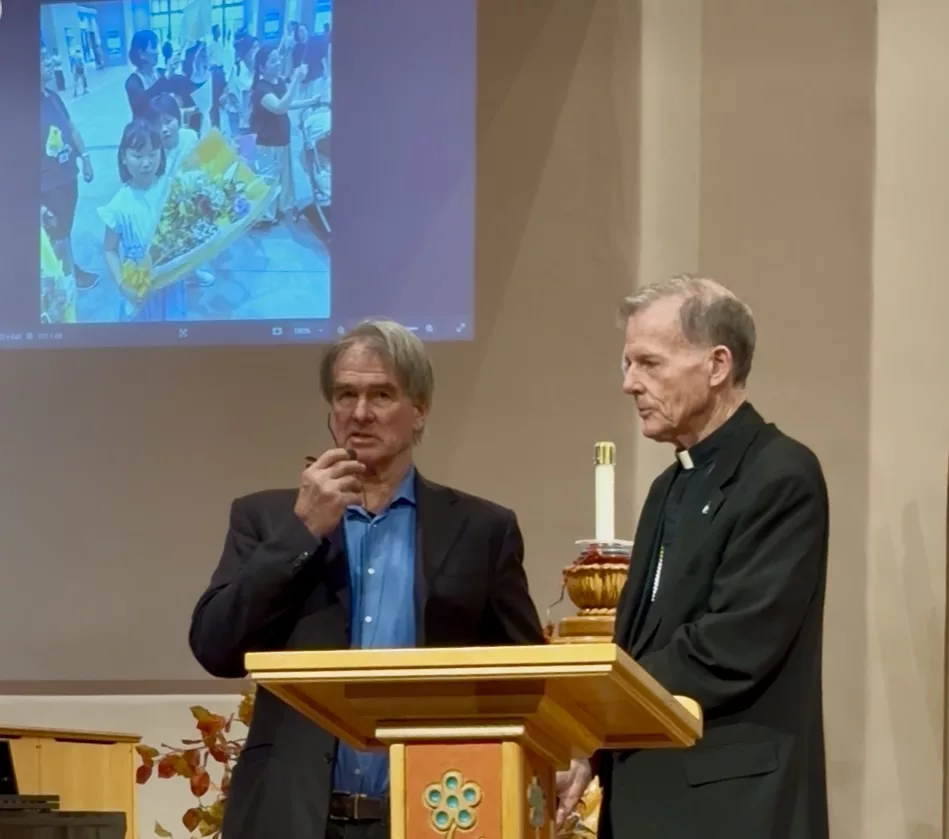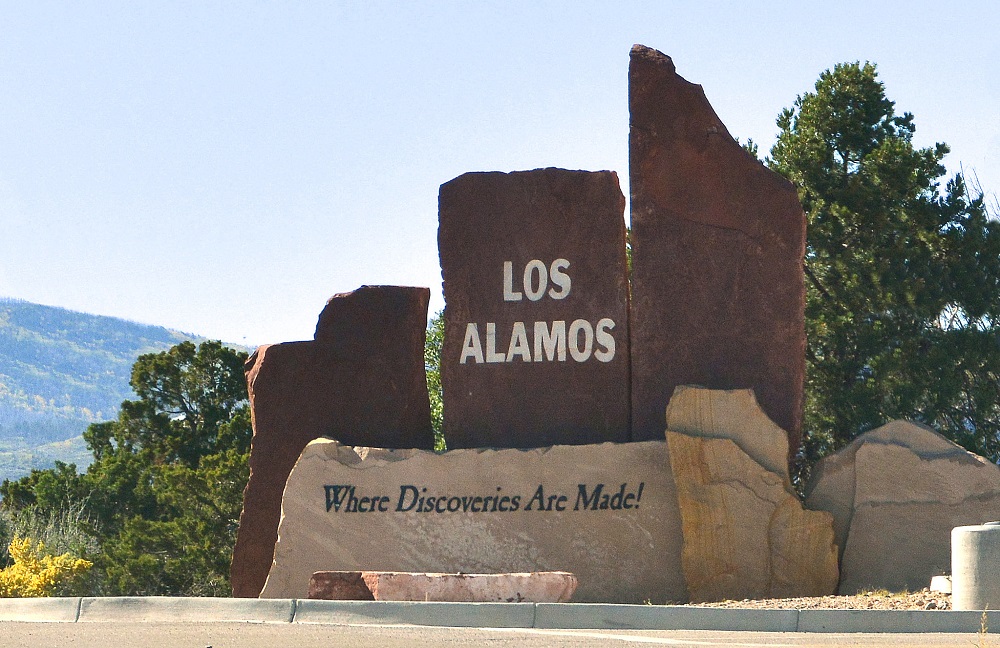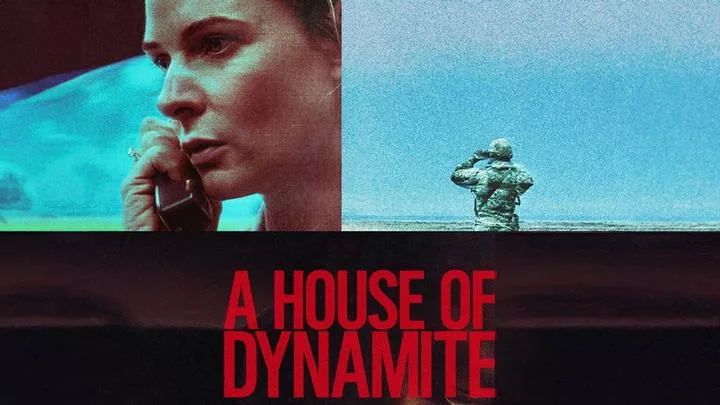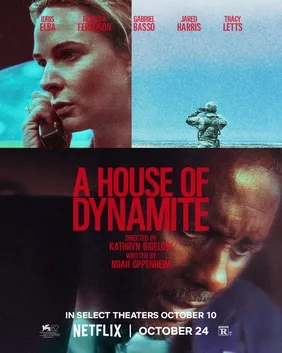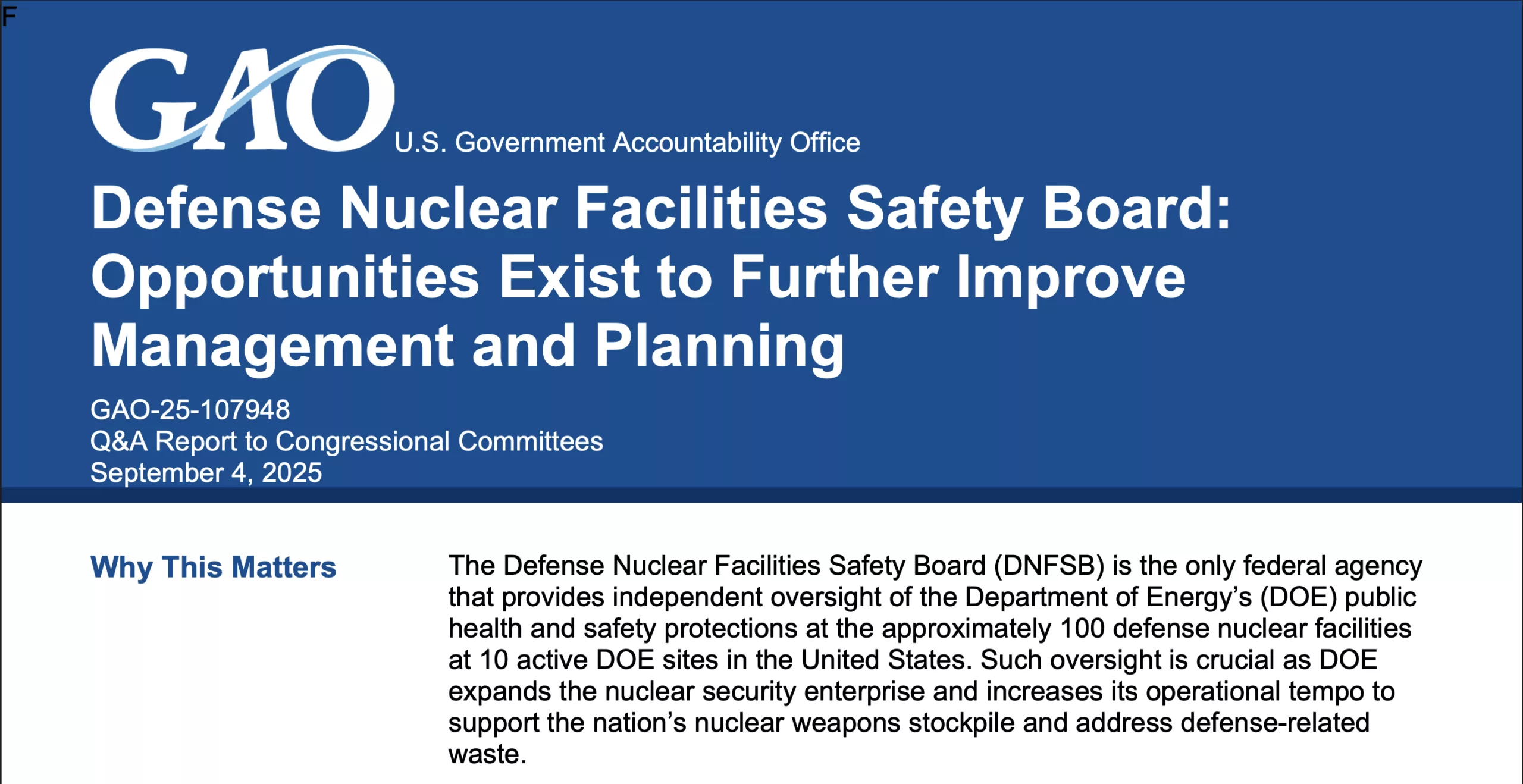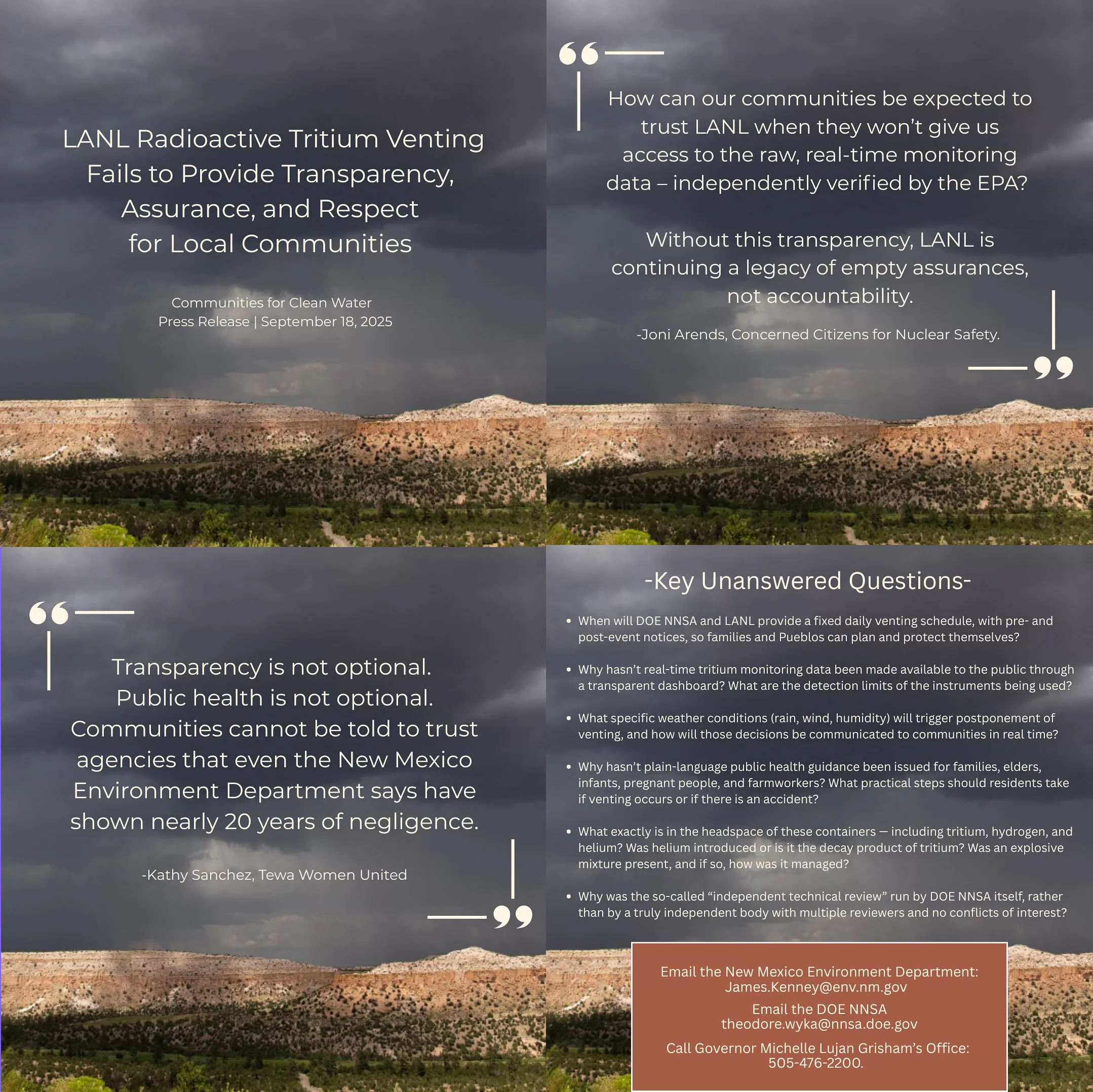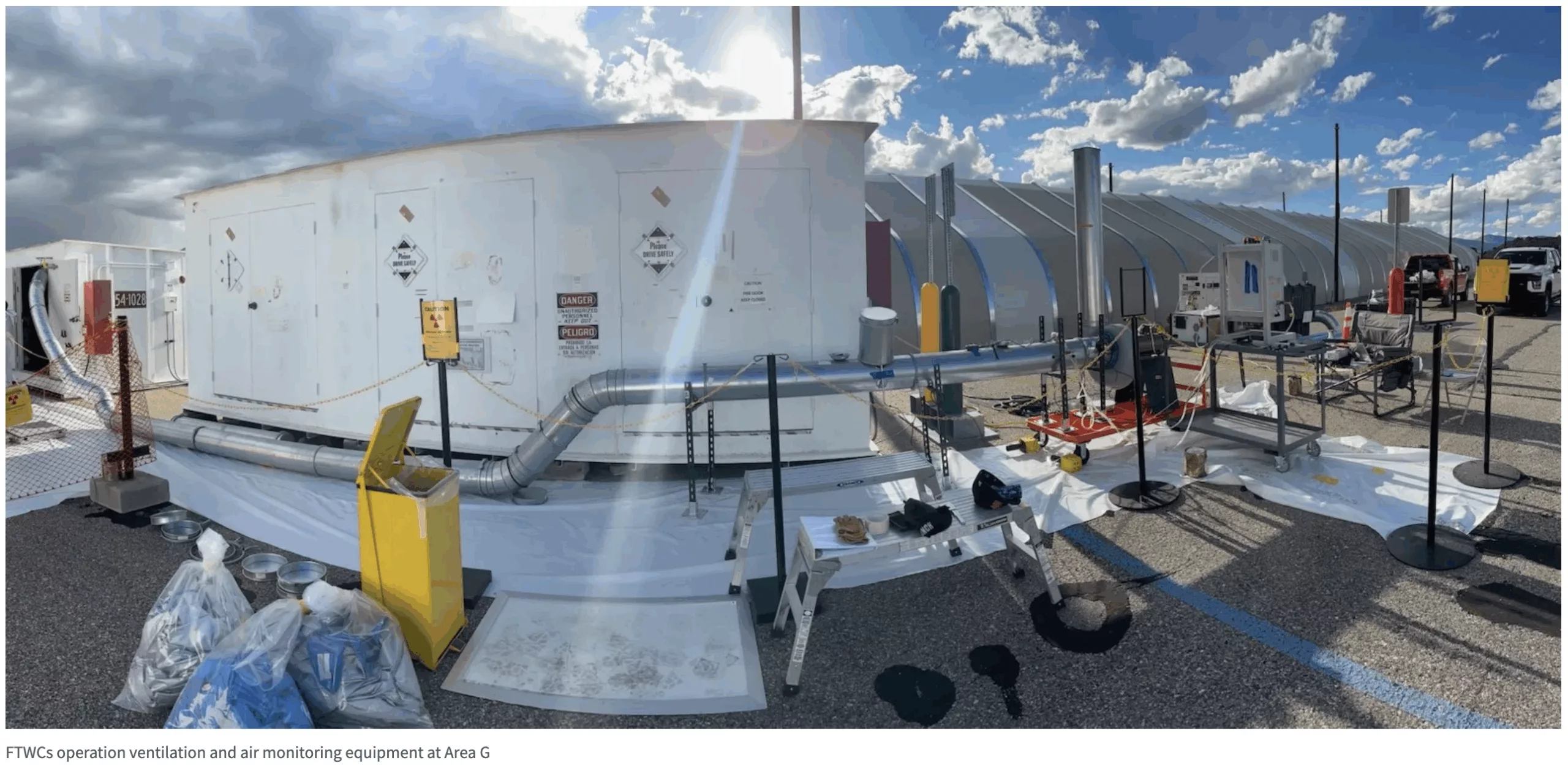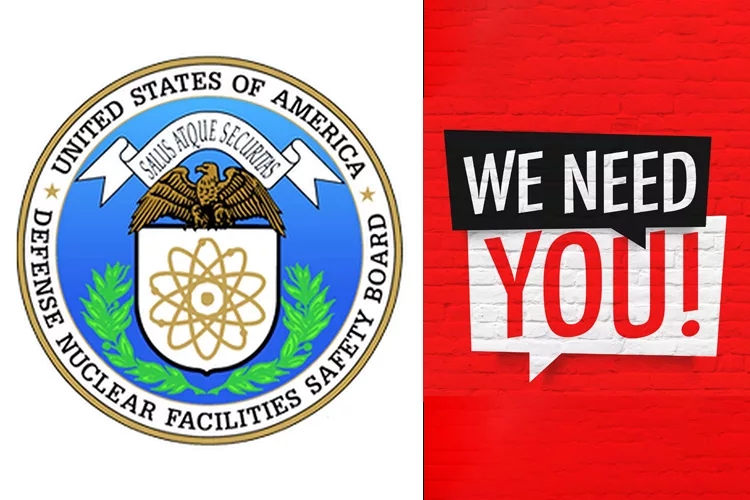What might Project 2025 mean for N.M.? Non-nuclear cuts at national labs (Updated Dec 1, 2025)
“[The Heritage Foundation’s Project 2025] contemplates pulling funding from any work unrelated to nuclear weapons at Los Alamos National Laboratory, Sandia National Laboratories and sister facility Lawrence Livermore National Laboratory in California…in New Mexico, some say cutting the labs’ other scientific work would have a devastating economic effect on the state and could ultimately weaken the institutions as a whole.”
“It doesn’t take a nuclear physicist to realize that there could be massive layoffs if this proposal or these ideas were to reach fruition,” said Chandler, who worked in the employment arena for much of her time at the facility. “Now, that might expand the nuclear weapons program to some degree, but it’s not going to absorb the entire workforce.”
“Under the Biden administration, LANL has seen a massive growth in employment as the laboratory ramps up for its production of plutonium pits, the cores of nuclear bombs.”
By Gabrielle Porter and Alaina Mencinger gporter@sfnewmexican.com amencinger@sfnewmexican.com | Updated santafenewmexican.com
Project 2025 — the now-infamous blueprint for a conservative presidency that’s still publicly being held at arm’s length by Republican presidential candidate Donald Trump — proposes all sorts of sweeping policy recommendations, from promoting capital punishment to embracing mass deportations.
But tucked in the 922 pages of its report, “Mandate for Leadership 2025: The Conservative Promise,” is one recommendation that centers squarely on New Mexico.
Trump talk on nuke testing turns focus to New Mexico’s role in decades of blasts
Jay Coghlan, executive director of the nuclear watchdog group Nuclear Watch New Mexico, said Wright’s comments “somewhat” quelled his initial concerns about a renewed explosive nuclear testing program.
But he said claims Russia and China may be conducting small-scale tests known as hydronuclear tests — banned by the Comprehensive Nuclear Test Ban Treaty, of which the United States, Russia and China are all signatories — continue to give him pause. He fears rumors about the low-yield tests in other nations could be used to justify a domestic return to testing.
“That, in effect, would give permission to the U.S. [to resume testing],” Coghlan said. “But that would be in violation of the norm of the CTBT.”
Three decades removed from the United States’ last nuclear test, a testing regimen would likely be expensive and time-consuming to start up, Coghlan argued, and could prompt other nuclear powers to follow suit.
It seems likely Russia, at least, would: Following Trump’s post, Russian President Vladimir Putin announced if the United States resumed explosive nuclear testing, the Eastern European nation would follow.
“Then everybody else is going to do it, or virtually everybody else will do it, every other nuclear weapons power,” Coghlan said. “I could just see India and Pakistan champing at the bit to test. And then, of course, there’s North Korea and China.”
By Alaina Mencinger amencinger@sfnewmexican.com | November 30, 2025 santafenewmexican.com
It might not have as reverent a name as the Trinity Test or a litany of films made about it. But Project Gnome, a 1961 explosive nuclear test conducted near Carlsbad, is a relic of a bygone era in New Mexico and beyond.
In the 47 years between the Trinity Test and the end of the United States’ explosive nuclear testing in 1992, the nation would perform more than 1,000 such tests — more than any other nuclear nation — with most conducted in Nevada.
New Mexico might not have been the center of the nation’s testing efforts post-Trinity, which marked its 80th anniversary this year, but the state still played a role: Researchers from Sandia National Laboratories and Los Alamos National Laboratory helped design and conduct testing elsewhere, including at the Nevada Test Site and in the Marshall Islands.
Most Democrats and one-third of Republicans think it’s likely the U.S. will get into a nuclear war in the next decade
A new YouGov poll on nuclear weapons finds that nearly half of Americans believe it’s likely the U.S. will get into a nuclear war in the coming decade, and most are worried about personally experiencing a nuclear war. A majority believe nuclear weapons are making the world less safe, but opinions are mixed on whether the U.S. should dismantle all of its nuclear weapons.
By: Jamie Ballard| November 26, 2025 today.yougov.com
46% of Americans think it’s likely the U.S. will get into a nuclear war within the next 10 years; 37% think this is not very or not at all likely. 57% of Democrats and 37% of Republicans think this is likely.
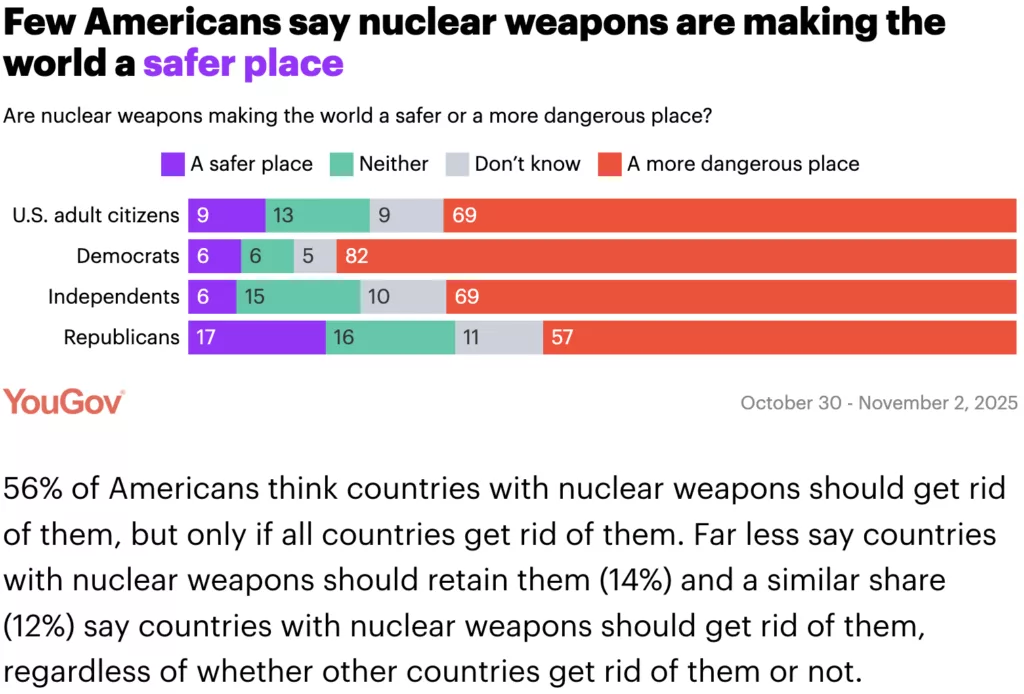
Department of Energy Seeks to Eliminate Radiation Protections Requiring Controls “As Low As Reasonably Achievable”
An internal Department of Energy (DOE) memorandum eliminates worker and public radiation protection rules known “As Low As Reasonably Achievable” (ALARA). This fundamental departure from decades of accepted health physics practices is being promoted by senior DOE political appointees with little background in health or radiation control. It is marked as “URGENCY: High” under the auspices of the DOE Deputy Secretary, the Under Secretary for Science, and the Administrator of the National Nuclear Security Administration. The memorandum awaits the final signature of DOE Secretary Chris Wright.
The memo’s stated goal is to:
“…remove the ALARA principle from all DOE directives and regulations, including DOE Order 458.1, Radiation Protection of the Public and the Environment, NE [Office of Nuclear Energy] Order 458.1, Radiation Protection of the Public, and, upon completion of the rulemaking process, 10 CFR [Code of Federal Regulations] 835, Occupational Radiation Protection.” [1]
It follows the playbook of the Heritage Foundation’s Project 2025, which called for:
“Set[ting] clear radiation exposure and protection standards by eliminating ALARA (“as low as reasonably achievable”) as a regulatory principle and setting clear standards according to radiological risk and dose rather than arbitrary objectives.” [2]
Lab Chromium Contamination Confirmed on San Ildefonso Pueblo Land
Comprehensive Cleanup Needed Instead of More Nuclear Weapons
The New Mexico Environment Department has announced:
“A toxic chromium plume from Los Alamos National Laboratory has spread beyond Lab boundaries onto Pueblo de San Ildefonso land for the first time, with contamination exceeding state groundwater standards… These new results are conclusive evidence that the U.S. Department of Energy’s efforts to contain the chromium plume have been inadequate.”
In reality, chromium groundwater contamination probably migrated beyond the LANL/San Ildefonso Pueblo boundary long ago, with past Lab maps of the plume “magically’ stopping at the border. In the past, tribal leadership has commented that it was fortunate that the contamination stopped there, but that any future indications of groundwater contamination on Pueblo land could have serious consequences. The San Ildefonso Pueblo is a sovereign Native American tribal government.
As late as the late 1990s the Lab was falsely claiming that groundwater contamination was impossible because underlying volcanic tuff is “impermeable.” [1] This ignored the obvious fact that the Parajito Plateau is heavily seismically fractured, providing ready pathways for contaminant migration to deep groundwater. By 2005 even LANL acknowledged that continuing increasing contamination of the regional aquifer is inevitable.[2] Some 300,000 northern New Mexicans rely upon the aquifer for safe drinking water. The potential serious human health effects (including cancer) caused by chromium contamination was the subject of the popular movie Erin Brockovich.
LANL chromium plume spreads onto San Ildefonso Pueblo land, NMED says
Nuclear Watch New Mexico executive direcor Jay Coghlan sees PF-4 as being a bigger scale — and having bigger risks — than the other aging buildings.
“PF-4 is not unique in being old,” Coghlan said. “However, PF-4 is totally unique in currently being the only facility that can process large amounts of plutonium … particularly including plutonium pit production. I think, in part, that’s why the Safety Board focuses more on PF-4 than, to my knowledge, than any other single individual facility.”
By:Patrick Lohmann | November 13, 2025 sourcenm.com
An underground plume of toxic chromium has spread from Los Alamos National Laboratory to Pueblo de San Ildefonso land, state Environment Department officials announced Thursday.
The discovery marks the first time the plume has been detected within the pueblo boundaries, officials said in a news release, though they added the plume’s spread does not pose imminent threats to drinking water in the pueblo or in Los Alamos County. That’s because the plume is not near any known private or public wells, officials said.
Long-term ingestion of hexavalant chromium can cause serious health problems or increase risk of certain cancers.
US Stands Alone Defying UN Vote on Nuclear Test Ban Treaty
Could the LDS Church end an ongoing nuclear weapons project? These veteran activists think so.
By Thalif Deen, Inter Press Sevice | November 12, 2025 ipsnews.net
UNITED NATIONS, Nov 12 2025 (IPS) – The US took another step backward –to break ranks with the United Nations– when it voted against a draft resolution calling for the entry into force of the Comprehensive Nuclear-Test-Ban Treaty (CTBT).
The negative vote followed an announcement by President Trump last month that the US plans to resume nuclear testing after a 33-year hiatus. The US stood alone on the UN vote, which was supported by almost all member States in the General Assembly’s First Committee.
The resolution was adopted by an overwhelming majority: with 168 votes in favor, with one against (United States) and 3 abstentions (India, Mauritius, Syria).
During Trump’s first term, the US abstained on the vote. And in other years they had been voting in favour.
Jackie Cabasso, Executive Director, Western States Legal Foundation, which monitors and analyzes U.S. nuclear weapons programs and policies, told IPS the chaos and uncertainty arose from Trump’s factually-challenged social media post that “because of other countries testing programs, I have instructed the Department of War to start testing our Nuclear Weapons on an equal basis.”
The U.S. government’s first ever “No” vote, on the annual UN resolution in support of the Comprehensive Test Ban Treaty (CTBT), raises further troubling questions about U.S. intentions.
Harking to the MX, Utahns call on LDS Church President Oaks to speak out against nuclear missile being developed in Utah
Could the LDS Church end an ongoing nuclear weapons project? These veteran activists think so.
THE SALT LAKE TRIBUNE | November 9, 2025 sltrib.com
Decades ago, peace activists helped keep a major nuclear weapons system out of Utah with help from key figures, chiefly Spencer W. Kimball, then the president of The Church of Jesus Christ of Latter-day Saints.
Now some of those same individuals are calling on the church’s newly ascended president, Dallin H. Oaks, to follow in his predecessor’s footsteps and speak out against the federal government’s development of a new generation of nuclear missile, known as Sentinel, partly in the Beehive State.
“The arms race continues,” the group of 12 Utahns and one former resident write in a letter mailed to church headquarters in early October, “and a new moral challenge faces” the leaders of the Utah-based faith.
Nuclear Weapons Issues & The Accelerating Arms Race: November 2025
Nuclear weapons:
The government shutdown has impact:
National Nuclear Security Agency confirms 152 furloughed at offices in Albuquerque, Los Alamos
Only 14 employees remain at the two sites By: Danielle Prokop-October 22, 2025
The NNSA confirmed 152 New Mexico employees charged with overseeing national laboratories’ nuclear weapons work were furloughed on Oct. 20, 2025. (Courtesy of NNSA)
The federal government this week sent home more than 150 federal New Mexico employees charged with overseeing national laboratories’ nuclear weapons work, with only 14 employees across two sites remaining at work, the National Nuclear Security Agency confirmed to Source NM.
The furloughs include 71 employees at NNSA’s Los Alamos field office and 81 at the Sandia National Laboratories location, NNSA Deputy Director of Communications Laynee Buckels told Source NM in an email. Seven employees remain at each site, working without pay, she said.
The field offices are responsible for “ensuring compliance with federal contracts to manage and operate the national security assets,” according to the NNSA website
To date there doesn’t appear to be furloughs at LANL, whose employees technically work for a contractor rather than the federal government. Congress is not furloughed, but Speaker Mike Johnson has kept the House out of session. As a result, legislation has come to a screeching halt.
Los Alamos’ plutonium facility safety systems need improvement, oversight board says
Nuclear Watch New Mexico executive direcor Jay Coghlan sees PF-4 as being a bigger scale — and having bigger risks — than the other aging buildings.
“PF-4 is not unique in being old,” Coghlan said. “However, PF-4 is totally unique in currently being the only facility that can process large amounts of plutonium … particularly including plutonium pit production. I think, in part, that’s why the Safety Board focuses more on PF-4 than, to my knowledge, than any other single individual facility.”
By Alaina Mencinger amencinger@sfnewmexican.com | November 7, 2025 santafenewmexican.com
An independent oversight agency wants to see improved safety systems at the facility at the heart of Los Alamos National Laboratory’s plutonium pit mission: PF-4.
The Defense Nuclear Facilities Safety Board reported what it believes to be gaps in a safety analysis drafted for PF-4 and delays in upgrades to safety systems in a letter last month to Energy Secretary Chris Wright.
“Maintaining momentum for these safety infrastructure projects is more important in light of the issues with the safety analysis,” the board wrote in the letter dated Oct. 10. It was signed by former acting chairman Thomas Summers.
LANL Prioritizes Plutonium “Pit” Bomb Core Production Over Safety
The independent Defense Nuclear Facilities Safety Board recently released its Review of the Los Alamos Plutonium Facility Documented Safety Analysis. It concluded that:
“While LANL facility personnel continue to make important upgrades to the Plutonium Facility’s safety systems, many of those projects have encountered delays due to inconsistent funding and other reasons. DOE and LANL should consider prioritizing safety-related infrastructure projects to ensure that the Plutonium Facility safety strategy adequately protects the public, as the facility takes on new and expansive national security missions.” (Page 24)
In early October 2024, the Department of Energy’s semi-autonomous National Nuclear Security Administration (NNSA) announced with great fanfare that the Los Alamos Lab had produced its first “diamond stamped” plutonium pit for the nuclear weapons stockpile. Tens of billions of taxpayers’ dollars have been sunk into LANL’s long delayed and over budget pit production program. Given no further announcements, it is not currently known whether or not the Lab is meeting its congressionally required production goals. Endemic nuclear safety problems have long been an intractable issue, at one point even forcing a three-year halt to plutonium operations at LANL’s Plutonium Facility-4 (“PF-4”).
In its recent Review, the Safety Board reported:
“The [2009] Plutonium Facility safety basis described very large potential [radioactive] dose consequences to the public following seismic events…. DOE committed to upgrade and seismically qualify the ventilation system, with a particular focus on a specific ventilation subsystem…”
“As the only facility in the DOE complex that can process large quantities of plutonium in many forms, [PF-4] represents a unique capability for the nation’s nuclear deterrent. The Board has long advocated for the use of safety-related active confinement systems in nuclear facilities for the purposes of confining radioactive materials…Passive confinement systems are not necessarily capable of containing hazardous materials with confidence because they allow a quantity of unfiltered air contaminated with radioactive material to be released from an operating nuclear facility following certain accident scenarios. Safety related active confinement ventilation systems will continue to function during an accident, thereby ensuring that radioactive material is captured by filters before it can be released into the environment… (Page 2, bolded emphases added)
AP: Trump appears to suggest the US will resume testing nuclear weapons for first time in 30 years
“For Trump, who has cast Russia as a “paper tiger” for failing to swiftly subdue Ukraine, the message is that Russia remains a global military competitor, especially on nuclear weapons, and that Moscow’s overtures on nuclear arms control should be acted on.”
By MICHELLE L. PRICE and CHRIS MEGERIAN | October 30, 2025 apnews.com
BUSAN, South Korea (AP) — President Donald Trump appeared to suggest the U.S. will resume testing nuclear weapons for the first time in three decades, saying it would be on an “equal basis” with Russia and China.
The Kremlin pointed out that a global ban on nuclear tests has remained in place, but warned that if any country resumes nuclear testing Russia would follow suit.
There was no indication the U.S. would start detonating warheads, but Trump offered few details about what seemed to be a significant shift in U.S. policy.
He made the announcement on social media minutes before he met with Chinese leader Xi Jinping on Thursday in South Korea. He offered little clarity when he spoke to reporters later aboard Air Force One as he flew back to Washington.
The U.S. military already regularly tests its missiles that are capable of delivering a nuclear warhead, but it has not detonated the weapons since 1992. The Comprehensive Nuclear Test Ban Treaty, which the U.S. signed but did not ratify, has been observed since its adoption by all countries possessing nuclear weapons, North Korea being the only exception.
REUTERS: Trump tells Pentagon to immediately resume testing US nuclear weapons
“Russia – which tested a new nuclear-powered cruise missile on October 21, held nuclear readiness drills on October 22 and tested a new nuclear-powered autonomous torpedo on October 28 – said it hoped Trump had been properly informed that Moscow had not tested a nuclear weapon itself.”
By Trevor Hunnicutt, Ismail Shakil and Kanishka Singh | October 30, 2025 reuters.com
VIEW THE RECORDING: Santa Fe Ecumenical Conversations Towards Nuclear Disarmament at Santa Maria de la Paz Catholic Community – Monday, October 27
Archbishop John C. Wester and NukeWatch New Mexico presented a special evening at Santa Maria de la Paz Catholic Community on Monday, October 27, from 6:00 to 8:00 p.m. MT. Following a presentation from NukeWatch executive director Jay Coghlan on U.S. nuclear weapons “modernization,” the Archbishop shared reflections from his pastoral letter, Living in the Light of Christ’s Peace, and speak about the importance of dialogue and hope in working toward nuclear disarmament.
View the recording at https://www.youtube.com/watch?v=9LFmQzMoJds&t=1s
Trump Orders Nuclear Weapons Testing for New Nuclear Arms Race
New Plutonium “Pit” Bomb Cores at Los Alamos Lab Could Make It Real
Just minutes before meeting with Chinese President Xi Jinping, Trump posted on his Truth Social media platform that “Because of other countries testing programs, I have instructed the Department of War to start testing our Nuclear Weapons on an equal basis. That process will begin immediately.” House Speaker Mike Johnson soon followed on CNN saying, “I think it is an obvious and logical thing to ensure that our weapons systems work.”
No other countries are currently testing nuclear weapons (the last was by North Korea in 2017). Further, any nuclear weapons tests by the U.S. would be performed by the Department of Energy (whose last test was in 1992), not the Department of War (until recently the Department of Defense). Trump was likely referring to Vladimir Putin’s recent claims of a new nuclear powered cruise missile and a tsunami-causing nuclear-armed torpedo that could threaten America’s coastal cities. In addition, China is dramatically expanding its own fleet of intercontinental ballistic missiles.
But central to all this is the U.S.’ own $2 trillion “modernization” program that will rebuild every nuclear warhead in the planned stockpile with new military capabilities and produce new-design nuclear weapons as well. This so-called modernization program will also build new nuclear weapons production facilities expected to be operational until ~2080, and buy new missiles, subs, and bombers from the usual rich defense contractors, all to keep nuclear weapons forever.
‘Nuclear weapons are blasphemous’: Archbishop Wester continues disarmament push with talk
This event was organized by the “Santa Fe Ecumenical Conversations Towards Nuclear Disarmament” group at the Santa Maria de la Paz parish near the Santa Fe Community College. They kindly invited NukeWatch to speak before Archbishop Wester for what turned out to be a wonderful event. The full recording can be viewed at https://www.youtube.com/@SMDLP/streams
By Cormac Dodd cdodd@sfnewmexican.com | October 28, 2025 santafenewmexican.com
Despite saying he has received a somewhat muted response from the local faithful, Santa Fe’s Catholic archbishop is still pushing nuclear disarmament as vital to humanity’s spiritual well-being and continued existence.
“I think nuclear weapons are blasphemous, because I think nuclear weapons are humanity’s attempt to build a Tower of Babel, an attempt to eat from the apple of the tree of the Garden of Eden, to become like God, to become gods,” Archbishop John C. Wester said in a roughly 30-minute address at Santa Maria de la Paz Catholic Church south of Santa Fe.
“In humility, we must avoid inventing anything that, in a matter of hours, can destroy what God has created,” the leader of the Archdiocese of Santa Fe continued. “The story of Adam and Eve is archetypal, I think: When human beings try to become as God, they lose the Garden of Eden and they must endure the cruel reality of paradise lost.”
The archbishop’s comments followed a journey he undertook to Japan on the 80th anniversary of the U.S. military’s decision to drop atomic bombs on Hiroshima and Nagasaki toward the end of World War II. He spoke in front of an audience of about 50 people — who gave Wester a standing ovation — at Monday’s event
In a Looming Nuclear Arms Race, Aging Los Alamos Faces a Major Test
The lab where Oppenheimer developed the atomic bomb is the linchpin in the United States’ effort to modernize its nuclear weapons. Yet the site has contended with contamination incidents, work disruptions and old infrastructure.
By Alicia Inez Guzmán | October 28, 2025 The New York Times nytimes.com
In a sprawling building atop a mesa in New Mexico, workers labor around the clock to fulfill a vital mission: producing America’s nuclear bomb cores.
The effort is uniquely challenging. Technicians at Los Alamos National Laboratory must handle hazardous plutonium to create the grapefruit-size cores, known as pits. They do so in a nearly 50-year-old building under renovation to address aging infrastructure and equipment breakdowns that have at times disrupted operations or spread radioactive contamination, The New York Times found.
Now, the laboratory is under increasing pressure to meet the federal government’s ambitions to upgrade the nation’s nuclear arsenal. The $1.7 trillion project includes everything from revitalizing missile silos burrowed deep in five states, to producing new warheads that contain the pits, to arming new land-based missiles, bomber jets and submarines.
But the overall modernization effort is years behind schedule, with costs ballooning by the billions, according to the Congressional Budget Office. In 2018, Congress charged Los Alamos with making an annual quota of 30 pits by 2026, but by last year it had produced just one approved for the nuclear stockpile. (Officials have not disclosed whether more have been made since then.)
*The featured image differs from the article photo due to usage rights.
Why Putin’s ‘invincible’ nuclear-powered missile is more likely to become a disastrous ‘flying Chernobyl’ for Russia
The US abandoned efforts to build nuclear-powered missile weapons during the 1950s arms race with the Soviet Union as a nuclear-powered missile would effectively be a huge radiation risk.
Jeffrey Lewis, a nuclear nonproliferation expert at Middlebury College, described it as a “tiny flying Chernobyl,” referencing the Soviet power plant that melted down and covered a 1,600-mile area with toxic radiation…While Lewis believes the Burevestnik is only capable of subsonic speed and easy to intercept, he warned that Russia’s ambition poses a return to the Cold War era.
“NATO aircraft could intercept it. The problem is that Burevestnik is yet another step in an arms race that offers no victory for either side,” he wrote on X.
By Ronny Reyes | October 28, 2025 nypost.com
Russian strongman Vladimir Putin’s latest threats that Moscow is preparing to deploy its new “invincible” nuclear-powered cruise missile has drawn a rebuke from President Trump and a reminder of America’s own nuclear might.
But experts say the Burevestnik missile could end up being more like a disastrous “flying Chernobyl” for Russia — and proves Putin is actually nervous about the possibility of the US giving Tomahawk cruise missiles to Ukraine.
George Barros, of the Washington-based Institute for the Study of War, described Putin’s ominous Sunday announcement as a form of fear mongering from a Kremlin afraid that the US could give Kyiv a much more conventional weapon — the tried and true Tomahawk.
Russia tested new nuclear-powered Burevestnik cruise missile
“For Trump, who has cast Russia as a “paper tiger” for failing to swiftly subdue Ukraine, the message is that Russia remains a global military competitor, especially on nuclear weapons, and that Moscow’s overtures on nuclear arms control should be acted on.”
By Guy Faulconbridge and Lidia Kelly Tim Balk | October 26, 2025 reuters.com
- Russia tests nuclear-capable Burevestnik missile
- Missile flew for 14,000 km, 15 hours
- Putin says it can pierce any missile defences
Trump Administration Providing Weapons Grade Plutonium to Sam Altman
“If there were adults in the room and I could trust the federal government to impose the right standards, it wouldn’t be such a great concern, but it just doesn’t seem feasible.”
By: Joe Wilkins | October 24, 2025 futurism.com
With the economy the way it is these days, it’s nice to have a little walking around money.
Donald Trump certainly thinks so. Since his return to the White House, the president has labeled 440 federal properties for possible sale, leased 13.1 million acres of public land for strip mining, and held a fire sale for satellites developed by NASA’s Jet Propulsion Lab.
In one of his wildest money moves to date, the Financial Times reports that Trump is now offering companies access to plutonium from America’s arsenal of cold war nuclear missiles.
On Tuesday, the US Department of Energy (DOE) launched an application for interested parties to apply for access to a maximum of 19 metric tonnes — a little under 42,000 pounds — of weapons-grade plutonium, which has long been a key resource undergirding the US nuclear arsenal.
One of the companies anticipated to receive shipments of the fissile isotope from the DOE is Oklo, a “nuclear startup” backed — and formerly chaired — by OpenAI CEO Sam Altman. Earlier in October, Oklo was one of four US companies chosen by the DOE to join a new pilot program meant to rush the testing and approval of experimental reactor designs.
As the FT reports, we won’t know for certain until December 31, when the DOE announces the companies selected to purchase the plutonium, but it’s likely Oklo will be among them. That’s stirring up plenty of anxiety throughout the scientific community, who say the relaxed approach to nuclear development is a major cause for alarm.
“If there were adults in the room and I could trust the federal government to impose the right standards, it wouldn’t be such a great concern, but it just doesn’t seem feasible,” Edwin Lyman, a physicist with the Union of Concerned Scientists told the FT.
U.S. Agency That Protects Nuclear Arsenal to Furlough Workers
Jay Coghlan, the executive director of Nuclear Watch New Mexico, a private group that monitors the agency, said it was unclear if the furloughs would have any immediate effect on nuclear safety. “As a baseline, the nuclear safety officers have always been understaffed. There is simply not enough federal oversight as is. And then you’re talking about furloughing more,” he added.
By Tim Balk | October 17, 2025 nytimes.com
![]() The National Nuclear Security Administration said 1,400 workers would be affected by Monday.
The National Nuclear Security Administration said 1,400 workers would be affected by Monday.
Nuclear weapons safety oversight in decline with Trump, Biden inaction
The lone independent federal agency responsible for ensuring safety at U.S. nuclear weapons sites — including Hanford in Washington state — will lose its ability to issue recommendations for safer work by January if the Trump administration doesn’t replenish its board, which this month dwindles to one member.
By Patrick Malone | October 15, 2025 seattletimes.com
The Defense Nuclear Facilities Safety Board ensures adequate public health and worker safety by scrutinizing hazardous work conducted by the U.S. Department of Energy and its contractors that produce and maintain the nuclear arsenal. If the Trump administration and Congress don’t move quickly to populate the board, it will be incapable of issuing formal safety recommendations to the Energy Department, according to a report last month from the Government Accountability Office, Congress’ investigative arm.
If the board is without a quorum of at least three members for a year, “the agency would essentially be able to offer only nonbinding advice to DOE,” according to the report.
“The whole idea of having the board in place is to provide the optics in addition to the substance,” Nathan Anderson, a Washington state-based director in the GAO’s natural resources division, told The Seattle Times.
The board does not have regulatory or enforcement authorities, but its advice carries significant weight and cannot be easily dismissed or disregarded, the GAO report states. The board’s recommendations to the U.S. secretary of energy are published for public comment, and the secretary must respond in writing. The board also reports each year to selected congressional committees on its recommendations to the Energy Department and any outstanding safety problems.
FULL ORIGINAL ARTICLE (SEATTLE TIMES)
YOU CAN HELP SAVE THE DNFSB TODAY:
Continue reading
New Article about “Participatory Democracy in Action” Describes WIPP Permit Negotiations
Thanks to our friends at Concerned Citizens for Nuclear Safety for this article:
In an essay for NYU’s Democracy Project, David F. Levi, a former federal judge and director emeritus of the Bolch Judicial Institute at Duke Law, reflected on the negotiations he facilitated in New Mexico about the renewal of the hazardous waste permit for the Waste Isolation Pilot Plant (WIPP), a deep geologic repository for plutonium-contaminated waste generated in the fabrication of nuclear weapons. Judge Levi’s essay is entitled “Participatory Democracy in Action.” He wrote:
 “A couple of years ago, I was asked to mediate a dispute between the U.S. Department of Energy (DOE) and the New Mexico Environment Department (NMED) concerning the renewal of a required state permit for DOE’s Waste Isolation Pilot Plant (WIPP), the nation’s only deep underground nuclear waste storage facility, located outside of Carlsbad, New Mexico. I thought I could help the two government entities but quickly came to realize that under the mediation procedures followed by New Mexico, the mediation would also involve citizen groups whose ultimate concurrence was essential to any complete resolution. This was entirely new to me.
“A couple of years ago, I was asked to mediate a dispute between the U.S. Department of Energy (DOE) and the New Mexico Environment Department (NMED) concerning the renewal of a required state permit for DOE’s Waste Isolation Pilot Plant (WIPP), the nation’s only deep underground nuclear waste storage facility, located outside of Carlsbad, New Mexico. I thought I could help the two government entities but quickly came to realize that under the mediation procedures followed by New Mexico, the mediation would also involve citizen groups whose ultimate concurrence was essential to any complete resolution. This was entirely new to me.
“In this case, there were seven such citizen groups entitled to participate and representing a variety of points of view. There was one group representing some of the government and business leaders of the town of Carlsbad who favored permit renewal on terms ensuring the continued long-term operation of WIPP. There were six groups expressing a variety of concerns about nuclear waste coming to New Mexico. They sought a more restrictive permit.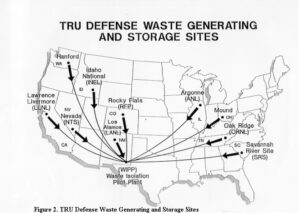
“To my astonishment, over the course of four full days, we worked through the multitude of issues and came to complete agreement. Something magical had happened. Thanks to the goodwill of the DOE and its contractor, the remarkable daily attendance and attentiveness of the NMED Secretary and the measured and well-informed way in which the various citizen groups made their points, we were able to find consensus and craft permit language that was acceptable to everyone.
“For me, as a former judge and mediator, the experience was thrilling. It was an experience of participatory democracy in action that made me proud of our fellow citizens and our government. Three aspects of the experience stand out. First, everyone in the room had taken responsibility for the way in which our nation’s only deep underground nuclear storage facility would be operated for the next 10 years. The citizen participants were not just making suggestions; they were assuming many of the attributes of decision makers. Second, all participants were advocating, compromising, and collaborating on behalf of what they saw as the public interest. These are the essential skills of democracy—the civic virtues so central to the Founders’ vision of what would make democracy work in America—and they require practice. Finally, over four days around a table, the citizens were able to take the measure of the DOE and NMED representatives. They came to realize, as I did, that these public servants, as well as the DOE contractor, were very well-informed, experienced, and intentioned. The government representatives had a similar experience of coming to appreciate the citizen questions and points of view. A government that relies on trust needs this kind of interaction to maintain that trust.
“It seems our democracy would be strengthened if we could extend the benefits of this kind of participatory structure to other areas of our legal and regulatory systems.”
“In Democracy in America, Alexis de Tocqueville made some of these points in reference to the jury trial in civil cases. He emphasized the importance of the civil jury trial as a free “public school” [https://contextus.org/Tocqueville,_Democracy_in_America_(1835),_Book_I,_Chapter_XVI_Causes_Mitigating_Tyranny_In_The_United_States_(Part_II).13?ven=Gutenberg&lang=en]  educating jurors in the democratic virtues and skills and teaching them to assume responsibility. In the same vein, every trial judge I know would attest to the importance of the jury experience for building confidence in the courts. After a trial, judges often hear words of gratitude from jurors who are deeply impressed by the legal process and are honored to have participated despite their initial dismay at being called to jury service. Sadly, the number of jury trials has diminished, particularly in federal court. Reversing that trend is a worthy goal, particularly for a branch of government that depends so heavily on public confidence.
educating jurors in the democratic virtues and skills and teaching them to assume responsibility. In the same vein, every trial judge I know would attest to the importance of the jury experience for building confidence in the courts. After a trial, judges often hear words of gratitude from jurors who are deeply impressed by the legal process and are honored to have participated despite their initial dismay at being called to jury service. Sadly, the number of jury trials has diminished, particularly in federal court. Reversing that trend is a worthy goal, particularly for a branch of government that depends so heavily on public confidence.
“As a final reflection: any persons involved as litigants will have an experience of the legal system. The experience can advance their sense of agency and participation, their ability to disagree civilly, and their trust in the courts. But how can these objectives be obtained when so many Americans cannot afford a lawyer? We can do so much better to provide understanding of and access to our justice system.”
The six New Mexico based non-governmental organizations were Citizens for Alternatives to Radioactive Dumping (CARD), Concerned Citizens for Nuclear Safety (CCNS), Conservation Voters New Mexico (CVNM), Nuclear Watch New Mexico, Southwest Alliance for a Safe Future (SAFE), and Southwest Research and Information Center (SRIC). The individual was Steve Zappe, a grandfather and former NMED WIPP Program Manager.
“A House of Dynamite” New Netflix Nuclear Catastrophe Film: Fiction, for Now
The reviews are rolling in for “A House of Dynamite,” which premiered in Europe earlier this month before coming to the U.S. on October 10th, with a full Netflix release scheduled for the 24th. Here’s the trailer, and see the schedule for Santa Fe theater showings here:
This Week! Santa Fe Theater Screenings for the Film “A House of Dynamite”
I attended one of these screenings last night, and I’ll let the professional critic reviews give the gist:
The Kathryn Bigelow thriller looks at what might happen if a ballistic missile were headed to the U.S. The director hopes the movie will start a conversation. New York Times: At Venice, ‘A House of Dynamite’ Is Scarier Than Most Horror Films
“The Netflix thriller captures from multiple perspectives the White House response to an unattributed missile launch headed for a major U.S. city in the harrowing 20 minutes until projected impact…”An unrelenting chokehold thriller so controlled, kinetic and unsettlingly immersive that you stagger out at the end of it wondering if the world will still be intact.” ‘A House of Dynamite’ Review: Idris Elba and Rebecca Ferguson in Kathryn Bigelow’s Precision-Tooled, Viscerally Unsettling Nail-Biter
“Told from the perspective of soldiers at a remote Alaskan missile base, staffers in the White House situation room, military officials at US Central Command (CENTCOM), and the president of the United States, the film weaves an overlapping timeline to show how the United States would respond to a missile attack…The film doesn’t want viewers to ask themselves how to thwart a nuclear attack on the United States. Rather, it wants the viewer to question the value of having nuclear weapons at all. ‘None of this makes sense,’ the President (Idris Elba) bemoans, ‘Making all these bombs and all these plans.'”
“A House of Dynamite is a terrifying examination of how terribly wrong things can go even with highly competent people in charge…But that’s also not necessarily the world we’re living in…The film shows why the worst can happen, even when competent, well-meaning people are trying to do the right thing.
But what if competence and decency are in short supply?” A House of Dynamite: Bigelow’s latest thriller shows why nuclear bombs are only part of the danger
This film left me reeling with tension and anxiety and exactly as the Times article titles it, is scarier than most horror films. Unlike ‘Oppenheimer,’ which largely glorified the invention of the atomic weapon, ‘A House of Dynamite’ makes it impossible to ignore the threat that nuclear weapons pose to our world. Working backwards from perspectives, and focused on how we can actually improve our odds of keeping this story a fictional one, here is what struck me most about this film:
-
-
Only one person decides what happens. But the real threat isn’t one reckless leader — it’s a reckless system. The final segment of the film features the “nuclear football” heavily, a briefcase containing launch procedures and options. In the United States, the president holds the sole and absolute authority to order the use of nuclear weapons. In the film, there are many voices in the President’s ear, but two primary perspectives quickly emerge after the defense fails and the ICBM remains inbound to its U.S. target: “One side advocates a retaliatory strike; the other, nothing. ‘It’s surrender or suicide,’ one adviser tells the President,” – thebulletin.org. The military aide carrying the nuclear football is tasked with providing the President the list of options if retaliation is chosen. An absolute must-read, Daniel Ellsberg’s book “The Doomsday Machine” breaks down many of the themes in the film with pure and terrifyingly honest account of Cold War-era nuclear strategy. In terms of launch authority, he describes how the inherent instability of the delegated command structure of the nuclear apparatus makes accidental or unwanted war an ever-present danger.
-
LANL tritium containers to head to Texas after last treatment
Four flanged tritium waste containers have been depressurized and transported to Los Alamos National Laboratory’s Weapons Engineering Tritium Facility, where they will be treated further before heading out-of-state for disposal.
By Alaina Mencinger amencinger@sfnewmexican.com | October 15, 2025 santafenewmexican.com
The containers’ final destination is Waste Control Specialists, a West Texas facility that handles the storage and disposal of radioactive waste.
The more than 1,300-acre facility in Andrews County is located on an approximately 14,000 acre property, which is sited on a thick clay formation which the company describes as “nearly impermeable.”
New documents have been added to the Los Alamos Legacy Cleanup Contract Electronic Public Reading Room.
All legacy cleanup documents required to be posted after April 30, 2018, are available on the site linked above.
For legacy cleanup documents that were posted prior to April 30, 2018, please visit the LANL electronic public reading room.
- Review, Notice of Completion of Off-Site Waste Shipments for Final Disposal, Activities 3.1.5, 3.1.8, and 3.3.4, Compliance Plan, Site Treatment Plan, Federal Facility Compliance Order Los Alamos National Laboratory [July 31, Aug. 21, 2025]
https://ext.em-la.doe.gov/GovFTPFiles/api/GetFiles/GetFile?fileName=EMID-703933_NMED_Review_STP_Shpmt_Jul_31_Aug_21_101525.pdf
Strong Political and Public Opposition Means Consolidated Interim Storage Facility (CISF) in NM “Impossible in the Near Future”
NEW UPDATE OCTOBER 10, 2025:
Holtec abandons plan to build New Mexico storage facility for spent nuclear fuel
This is excellent news. The Governor and state legislature (specifically Senator Jeff Steinborn and Representative McQueen) are to be commended for not allowing New Mexico to become the nation’s dumping ground for highly radioactive commercial spent fuel rods, especially when the Land of Enchantment has never had its own nuclear energy plant. Hard work from many New Mexicans made this happen.
So-called “interim” storage would never be interim when the federal government has failed for more than four decades to find a permanent repository for these lethal wastes. This also shows how hollow all the hype is about the claimed renaissance of nuclear power, when on the front end the industry can’t survive without taxpayer handouts, and on the back end can’t solve its radioactive waste problem.
Holtec’s quote that “New Mexico’s acquiescence is necessary” for interim storage to go forward is interesting, implying that we have to surrender as the nuclear colony that we are. Well, guess what, we didn’t surrender, and I predict you’ll see more of this. Moreover, whether you’re pro-nuclear or anti-nuclear, Holtec is an ethically questionable company, which is why the attorneys general of New Jersey and Massachusetts have sued it.
Adiós and good riddance, Holtec!
New York Times: Tax Break Scandal Leads to $5 Million Fine for N.J. Energy Company
SEE MORE:
Nuclear Weapons Issues & The Accelerating Arms Race: September 2025
Nuclear Weapons Update:
Putin has offered Trump a one-year extension of the numerical cap on strategic nuclear weapons in the new Strategic Arms Reduction Treaty which is 1,550 warheads (however, B52s are counted as one warhead while they can carry a dozen). New START expires in February 2026, which will be the first time the world will be without any nuclear arms control treaties since the mid-1970s. Trump has said it sounded like a good idea.
Note: New START ratification in 2010 provided the opportunity for Republicans in the Senate to attach the condition of $88 billion for nuclear weapons “modernization” that has since metastasized to ~$2 trillion. Nuclear disarmament must be prioritized as the ultimate goal over simply continued arms control.
A mere extension of the numerical cap would not involve Congressional ratification. The extension of New START’s numerical cap is in part to allow for a year in which to begin negotiations for a treaty replacement.
Plutonium Pit Production:
A draft plutonium pit production programmatic environmental impact statement is expected to be released next year in early 2026.
Accelerating Arms Race:
Is North Korea set to become world’s ‘fourth ICBM power’ after missile breakthrough? | Park Chan-kyong | South China Morning Post | September 11, 2025
A new era in North Korea’s missile programme may be dawning, as analysts warn of an imminent test launch of an intercontinental ballistic missile capable of carrying multiple warheads to the US mainland. Fresh from his appearance at China’s Victory Day parade in Beijing last week, North Korean leader Kim Jong-un personally oversaw the trial of a lighter, more robust solid-fuel ICBM engine, state media reported on Tuesday, touting the achievement as a “strategic” breakthrough.
Saudi Arabia signs a mutual defense pact with nuclear-armed Pakistan after Israel’s attack on Qatar | MUNIR AHMED & JON GAMBRELL | AP NEWS | September 18, 2025
DUBAI, United Arab Emirates (AP) — Pakistan’s defense minister says his nation’s nuclear program “will be made available” to Saudi Arabia if needed under the countries’ new defense pact, marking the first specific acknowledgment that Islamabad had put the kingdom under its nuclear umbrella.
Defense Minister Khawaja Mohammad Asif’s comments underline the importance of the pact struck this week between Pakistan and Saudi Arabia, which have had military ties for decades.
The move is seen by analysts as a signal to Israel, long believed to be the Middle East’s only nuclear-armed nation. It comes after Israel’s attack targeting Hamas leaders in Qatar last week killed six people and sparked new concerns among Gulf Arab nations about their safety as the Israel-Hamas war devastated the Gaza Strip and set the region on edge.
Russia suspected of helping North Korea build nuclear submarines, Seoul investigating | Park Chan-kyong | South China Morning Post | September 18, 2025
South Korea is investigating reports that Russia has supplied North Korea with nuclear submarine reactor modules, a move analysts see as highly plausible and one that could mark a breakthrough in Pyongyang’s decades-long push for a nuclear-powered navy… At the 8th Party Congress in January 2021, North Korea declared five core defence goals, including the development of nuclear-powered submarines and submarine-launched strategic nuclear weapons.
China Hardens Military Stance Against U.S. With Nuclear Weapons and Tough Talk | Brian Spegele | The Wall Street Journal| September 18, 2025
China played down its rapidly rising military might for years. In the past few weeks, Beijing has broadcast a steady drumbeat of firepower displays and muscular rhetoric, carrying an unmistakable warning for the U.S… Part of China’s confidence stems from the rapid growth of its firepower. The Pentagon estimates that China’s stockpile of nuclear warheads has more than doubled since 2020, alongside a growing array of options to launch those weapons, from mobile ground-launch systems to increasingly stealthy submarines.
Holtec Pulls Out of New Mexico Spent Nuclear Fuel Interim Storage Project
Holtec International has confirmed it is canceling plans to build a consolidated interim storage facility for spent nuclear fuel in southeastern New Mexico.
By Radwaste Solutions | October 9, 2025 ans.org
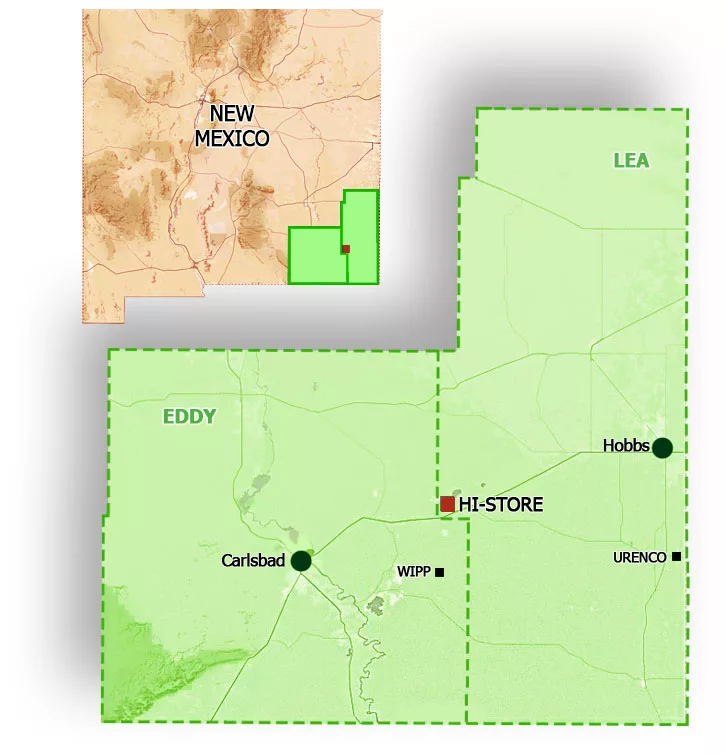
Named the HI-STORE CISF, the facility would have stored up to 10,000 canisters of commercial SNF on land owned by the Eddy-Lea Energy Alliance (ELEA) near the towns of Carlsbad and Hobbs.
“After discussions with our longtime partner in the HI-STORE project, the Eddy-Lea Energy Alliance, and due to the untenable path forward for used fuel storage in New Mexico, we mutually agreed upon canceling the agreement. This allows for ELEA to work to redevelop the property in a manner that fits their needs and allows Holtec to work with other states who are amenable to used fuel storage based on the recent DOE work on public education and outreach,” Holtec said in a statement (emphasis added).
Following the U.S. Supreme Court’s June ruling in NRC v. Texas, which found that petitioners did not have standing to challenge the Nuclear Regulatory Commission’s licensing of Interim Storage Partners’ CISF in Texas, Holtec said it expected to have its HI-STORE CISF license reinstated, allowing the company to move forward with the project. Holtec and ISP’s NRC licenses were vacated by the 5th Circuit Court of Appeals in a 2023 ruling.
Despite the court’s decision, New Mexico Gov. Michelle Lujan Grisham said she remained committed to preventing the HI-STORE CISF from being built. In 2023, New Mexico passed a bill barring the storage and disposal of high-level radioactive waste in New Mexico without the state’s explicit consent.
The AI Doomsday Machine Is Closer to Reality Than You Think
“Most troubling to experts on AI and nuclear weapons is that it’s getting harder and harder to keep decisions about targeting and escalation for nuclear weapons separate from decisions about conventional weapons.”
“There is no standing guidance, as far as we can tell, inside the Pentagon on whether and how AI should or should not be integrated into nuclear command and control and communications,” says Jon Wolfsthal, director of global risk at the Federation of American Scientists.
By Michael Hirsh | September 2, 2025 politico.com
Jacquelyn Schneider saw a disturbing pattern, and she didn’t know what to make of it.
Last year Schneider, director of the Hoover Wargaming and Crisis Simulation Initiative at Stanford University, began experimenting with war games that gave the latest generation of artificial intelligence the role of strategic decision-makers. In the games, five off-the-shelf large language models or LLMs — OpenAI’s GPT-3.5, GPT-4, and GPT-4-Base; Anthropic’s Claude 2; and Meta’s Llama-2 Chat — were confronted with fictional crisis situations that resembled Russia’s invasion of Ukraine or China’s threat to Taiwan.
Director Kathryn Bigelow is Sounding the Nuclear Alarm – Washington Post New Review
“A House of Dynamite” asks: How would the White House respond in the face of a nuclear attack?
By Max Boot | October 2, 2025 washingtonpost.com
VIEW MORE: “A House Of Dynamite” Q&A w/ Director Kathryn Bigelow, Tracy Letts, Jared Harris, And More At New York Film Fest —
80th Commemorations of Ban the Bomb – Trinity, Hiroshima & Nagasaki Remembrances in New Mexico
Exchange Monitor: DNFSB makes agency fixes, but needs members, GAO finds
The Defense Nuclear Facilities Safety Board (DNFSB) has tackled all but a few third-party recommendations to improve its culture over the past decade but suffers from a depleted board, according to a new report.
By ExchangeMonitor | September 5, 2025 santafenewmexican.com
Progress is tough with the five-person board probably…
China Hardens Military Stance Against U.S. With Nuclear Weapons and Tough Talk
Xi positions Beijing as powerful center of new global order as security forum convenes in capital
By Brian Spegele | September 18, 2025 wsj.com
BEIJING—China played down its rapidly rising military might for years. In the past few weeks, Beijing has broadcast a steady drumbeat of firepower displays and muscular rhetoric, carrying an unmistakable warning for the U.S….
Saudi Arabia signs a mutual defense pact with nuclear-armed Pakistan after Israel’s attack on Qatar
While not specifically discussing the bomb, the agreement states “any aggression against either country shall be considered an aggression against both,” according to statements issued by both Pakistan’s Foreign Affairs Ministry and the state-run Saudi Press Agency.
By MUNIR AHMED and JON GAMBRELL | September 18, 2025 apnews.com
ISLAMABAD (AP) — Saudi Arabia and nuclear-armed Pakistan have signed a mutual defense pact that defines any attack on either nation as an attack on both — a key accord in the wake of Israel’s strike on Qatar last week.
The kingdom has long had close economic, religious and security ties to Pakistan, including reportedly providing funding for Islamabad’s nuclear weapons program as it developed. Analysts — and Pakistani diplomats in at least one case — have suggested over the years that Saudi Arabia could be included under Islamabad’s nuclear umbrella, particularly as tensions have risen over Iran’s atomic program.
COMMUNITIES FOR CLEAN WATER: LANL Radioactive Tritium Venting Fails to Provide Transparency, Assurance, and Respect for Local Communities
FOR IMMEDIATE RELEASE: September 18, 2025
Santa Fe, NM — As NNSA and LANL continue operations to depressurize Flanged Tritium Waste Containers, Communities for Clean Water (CCW) calls out federal agencies for issuing vague assurances instead of transparent, verifiable data — and for dismissing community concerns with contradictory and incomplete statements that disregard what independent experts have found, the Department of Energy’s (DOE) own legal obligations, and the New Mexico Environment Department’s (NMED) acknowledgment that LANL has a long record of compliance failures.
“How can our communities be expected to trust LANL when they won’t give us access to the raw, real-time monitoring data – independently verified by the EPA,” asks Joni Arends with Concerned Citizens for Nuclear Safety. “Without this transparency, LANL is continuing a legacy of empty assurances, not accountability.”
Key Concerns:
-
Lack of real-time transparency – Since Friday (Sept. 12), the public has been forced to rely on NMED’s Facebook page for piecemeal updates. While LANL’s website provides very brief daily summaries, no near-real-time monitoring dashboard from DOE, NNSA, or LANL has been made available.
-
Vague assurances, not real information – NNSA’s updates claim “no tritium was released” while simultaneously telling the public to expect “very low levels of tritium” for subsequent venting. Without numbers, monitoring data, or detection thresholds, these phrases do not provide reassurance.
-
Weather risks – LANL has not disclosed thresholds for wind, rain, or humidity that would postpone venting. Communities watch weather shifts in real time but are left in the dark about how safety decisions are being made.
-
Dismissal of public health concerns – When asked for plain-language guidance that NMED stated LANL would provide, LANL responded only with “no offsite impact anticipated.” This is not meaningful and reassuring guidance, it’s a blanket dismissal that disregards independent expert findings and fails to meet DOE’s obligations to protect vulnerable populations.
-
Ignoring daily lifeways – Avoiding Pueblo Feast Days is not enough. This is harvest season, when outdoor cultural events, youth programs, and farming are in full swing. LANL’s scheduling continues to disregard these realities.
Unanswered Questions
Independent experts and community advocates have raised critical unanswered questions:
-
Unclear “depressurization” – LANL said “no internal pressure was found” in a container, but also claimed it was “depressurized.” If no pressure existed, what was released?
-
Unanswered helium questions – NMED stated helium was released, but LANL has not explained its origin. Was it introduced at sealing of the outer container, or a decay product of tritium?
-
Monitoring limits undisclosed – LANL has not disclosed the detection limits of its monitoring equipment. Readings “indistinguishable from zero” could still mask releases.
DOE NNSA Gives Misleading Statements on Native America Calling
On a recent Native America Calling program, DOE NNSA’s Los Alamos Field Office Deputy Director Pat Moss compared LANL venting to global natural tritium stocks. Independent expert Dr. Arjun Makhijani pointed out this comparison as misleading: “The problem is not global background, but local contamination. If venting occurs in rain and calm winds, local rainfall could exceed U.S. drinking water standards by hundreds to thousands of times.”
In their most recent public meeting, LANL admitted that infants could receive three times the radiation dose as adults. During the interview, Dr. Makhijani pressed this point – if adults are modeled at 6 mrem, that means infants could be at 18 mrem, nearly double the EPA’s 10 mrem compliance limit. Instead of addressing this directly, Mr. Moss provided a stock line, “We will be compliant with the regulatorily imposed release threshold and will be doing the calculations per the regulation.”
That is exactly the problem – hiding behind regulatory caps while ignoring clear evidence that infants, our most vulnerable, face exposures above legal limits.
DOE NNSA also pointed to the Defense Nuclear Facilities Safety Board (DNFSB) – an independent federal oversight body created by Congress – as if it had declared the tritium venting operation as “fully protective of the public”. That is misleading. First, the DNFSB has been operating without a quorum for months, limiting its ability to issue independent recommendations. Second, what the Board staff said in its July 2025 presentation was that the overall nuclear safety risk to the public is low if DOE’s proposed controls are followed. The DNFSB has also flagged ongoing safety concerns at LANL including deficiencies in Area G’s safety analysis and risk to workers.
First of four containers of tritium waste at LANL has been vented
The first of four flanged tritium waste containers awaiting removal from Los Alamos National Laboratory has been vented, the New Mexico Environment Department announced Tuesday afternoon.
By Alaina Mencinger amencinger@sfnewmexican.com | September 16, 2025 santafenewmexican.com
The container can now be moved for treatment at LANL and then, eventually, to an off-site disposal area.
No internal pressure was found in the first container, according to the National Nuclear Security Administration, suggesting the inner containers in the flanged tritium waste container hadn’t leaked. Air monitoring did not show an increase of tritium beyond background levels, the federal agency wrote.
No tritium emissions were released, the Environment Department wrote in its Tuesday post on X, formerly Twitter. Both the state agency and the U.S. Environmental Protection Agency are monitoring the process.
The depressurization of the containers is set to continue at 7 a.m. Wednesday, although the NNSA noted the schedule is subject to change due to weather. The four containers will be vented one at a time over an estimated two-week period.
*The featured image differs from the article photo due to usage rights.
New Mexicans Can Save the DNFSB; Contact Our Senators Today
From our friends at Concerned Citizens for Nuclear Safety:
The independent Defense Nuclear Facilities Safety Board has been dwindling from a five-member board to one member and may disappear if we, the People, do not raise our voices to support its essential nuclear safety work. The Safety Board needs at least two new members. And that needs to get done by Saturday, October 18th. https://www.dnfsb.gov/about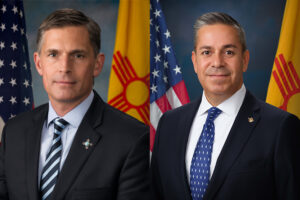
New Mexico U.S. Senators Heinrich and Lujan have key roles to play to ensure the Safety Board’s work continues unimpeded. https://www.heinrich.senate.gov/ and https://www.lujan.senate.gov/ Our voices of support are essential to ensure communities continue to receive the essential services of the Safety Board and its staff.
Right now members of the Safety Board’s staff are monitoring the venting of radioactive tritium from Area G at Los Alamos National Laboratory (LANL). Their expertise in the field of nuclear safety and their demonstrated competence and knowledge relevant to their independent investigative and oversight functions are an essential part of the process. They will be part of the follow-up once the venting of the four flanged tritium waste containers is completed. https://tewawomenunited.org/?s=tritium, https://www.ccwnewmexico.org/tritium, https://nuclearactive.org/
Not only does the Safety Board have staff at LANL, but also at Sandia National Laboratories in Albuquerque and at the Waste Isolation Pilot Plant, the burial site for plutonium contaminated nuclear weapons waste, near Carlsbad. https://ananuclear.org/facilities/
Russia suspected of helping North Korea build nuclear submarines, Seoul investigating
Analysts said such a technology transfer was plausible given Pyongyang’s support for Russia’s ongoing war in Ukraine
By Park Chan-kyong | September 18, 2025 scmp.com
South Korea is investigating reports that Russia has supplied North Korea with nuclear submarine reactor modules, a move analysts see as highly plausible and one that could mark a breakthrough in Pyongyang’s decades-long push for a nuclear powered navy…
Holy See tells nations at UN to end threat of nuclear weapons, even as deterrence
Amid a global arms race, ending the threat of nuclear war — and even the testing of nuclear weapons — is imperative, said the Holy See’s diplomat to the United Nations.
By Gina Christian, OSV News | September 8, 2025 catholicreview.org
Archbishop Gabriele G. Caccia, the Holy See’s U.N. permanent observer, shared his thoughts in a statement he delivered Sept. 4 at U.N. headquarters in New York, during the General Assembly High-level Plenary Meeting to Commemorate and Promote the International Day Against Nuclear Tests, observed that same day.
“The pursuit of a world free of nuclear weapons is not only a matter of strategic and vital necessity, but also a profound moral responsibility,” Archbishop Caccia in his remarks.
He pointed to the introduction of nuclear weapons — first detonated by the U.S. in 1945 over the Japanese cities of Hiroshima and Nagasaki, killing an estimated 110,000 to 210,000 people, during World War II — as unveiling to the world “an unprecedented destructive force.”
Historic peace vigil partially dismantled after Trump orders: ‘Take it down’
Law enforcement officials on Sunday removed parts of the White House Peace Vigil, which has sat just outside the White House for decades.
By Marissa J. Lang, The Washington Post | September 8, 2025 washingtonpost.com
But over the past week, it faced a new threat as Trump turned his attention to the vigil and federal officers picked apart the structure that shields protesters and their signs from the elements. The vigil is maintained by a rotating cast of volunteers who keep the protest going 24 hours a day, seven days a week.
On Friday, Brian Glenn, a correspondent for the conservative network Real America’s Voice, told the president during a gathering with reporters that there was “a blue tent” in front of the White House that was “an eyesore.” Trump initially said he was unaware of it, but he then quickly ordered its removal.
Photo by Sig. Chiocciola, Creative Commons: The White House Peace Vigil on March 30, 2025 staffed by volunteers, Philipos Melaku-Bello (left) and Joe Brown (right).
For 80 years, nuclear weapons have been the unused threat
Amid a global arms race, ending the threat of nuclear war — and even the testing of nuclear weapons — is imperative, said the Holy See’s diplomat to the United Nations.
By Matt Kelly, mkelly@virginia.edu, September 3, 2025 news.virginia.edu
In the 80 years since World War II, which ended with the use of two atomic bombs, the world has maintained a tenuous relationship with nuclear weapons.
Philip Potter, professor of public policy at the University of Virginia’s Frank Batten School of Leadership and Public Policy and director of the National Security Data and Policy Institute, said he worries about the current delicate nuclear balance.
“Eighty years of non-use is the product of both good diplomacy and a recognition of the potential consequences,” Potter said. “The fearsome power of nuclear weapons causes countries pause before they use them, but a great deal of work has also gone into nonproliferation and the management of crises to keep them away from the nuclear brink. In some ways the dynamics of the Cold War made managing the potential for nuclear confrontation easier.”
It’s a very different strategic scenario now, where there are nine nuclear powers and less capacity to manage them.
Nuclear News Archive – 2022
SC Gov. McMaster objects to plutonium settlement and the $75 million in attorneys fees
BY JOHN MONK & SAMMY FRETWELL / thestate.com
The day before South Carolina’s attorney general announced a settlement that will bring $600 million to the state and start the process of removing deadly plutonium stores, Gov. Henry McMaster said he couldn’t support paying private lawyers in the deal $75 million or waiting two decades for the waste to be gone.
In a letter to S.C. Attorney General Alan Wilson written Sunday, McMaster said the roughly $75 million in fees the state will pay four S.C. law firms that worked on the deal — orchestrated by Wilson, the state’s members of Congress and Trump administration lawyers — is grossly excessive for the work they did.
“I simply cannot endorse the payment of $75 million in attorneys’ fees under the circumstances,” McMaster, a former state attorney general, told Wilson in a letter written Sunday.
In his letter, McMaster also said Wilson’s settlement agreement doesn’t give enough assurances that the U.S. Department of Energy will remove the deadly plutonium from South Carolina “in a timely manner.” The plutonium is stored at the Savannah River Site.
SC settles lawsuit over plutonium waste for record $600M
“According to a release, under the terms of the settlement, the Dept. of Energy remains obligated to remove the plutonium by 2037.”
BY: Alexx Altman-Devilbiss | wpde.com
FILE – In this Sept. 29, 1994 file photo, a CSX Train with spent nuclear fuel passes through Florence, S.C., on its way to Savannah River Site Weapons Complex near Aiken S.C. Nevada and South Carolina are jostling for a home-field advantage of sorts in a federal court battle that could result in a metric ton of weapons-grade plutonium being stored 70 miles from Las Vegas. (Jeff Chatlosh/The Morning News via AP, File)COLUMBIA, S.C (WPDE) — Attorney General Alan Wilson Monday announced the federal government will pay South Carolina $600 million and clean up weapons-grade plutonium to end six years of litigation.
“This settlement is the single largest settlement in South Carolina’s history. It is important to me that the people of South Carolina know of our long-term commitment to preventing South Carolina from becoming a dumping ground for nuclear waste,” said Wilson. “Additionally, the more than half a billion dollars in settlement money could not come at a better time as our state government and economy work to overcome the revenue shortfalls caused by the COVID-19 pandemic. It has been a long, difficult road but I am proud of the leadership displayed by our state’s elected officials and the expertise of my legal team.”
Nuclear War Makes a Comeback
It’s time to revisit the old fear that kept your parents up at night
BY CAROL POLSGROVE / sierraclub.org
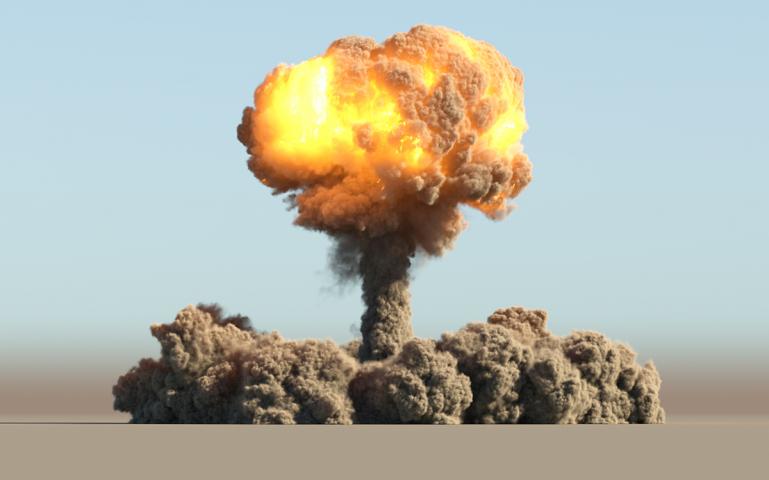
On websites where policymakers, scholars, and military leaders gather, concern about the possibility of nuclear war has been rising sharply in recent months as China, the United States, and Russia develop new weapons and new ways of using old ones.
On War on the Rocks, an online platform for national security articles and podcasts, Tong Zhao, a senior fellow at the Carnegie-Tsinghua Center for Global Policy, reported August 11 on public calls in China “to quickly and massively build up its nuclear forces” on the theory that only a “more robust nuclear posture” would prevent war with the United States.
The biggest nuclear arms budget ever is nearing approval in the US Congress, and the Trump administration has raised the possibility of resuming nuclear tests. President Trump has pulled the United States out of the 1987 Intermediate-Range Nuclear Forces (INF) treaty with Russia, while the New Start Treaty capping Russian and US nuclear warheads and delivery systems is set to expire next February if the two countries don’t agree to extend it.
Vatican representative calls on U.S. to sign nuclear-test-ban treaty
“The treaty is a critically important step toward creating a world without nuclear weapons…Each of the remaining eight states should strongly back up its words in favor of peace by being the first to sign.”
BY: Cindy Wooden | catholicnews.com
Pope Francis delivers a message about nuclear weapons at Atomic Bomb Hypocenter Park in Nagasaki, Japan, Nov. 24, 2019. (CNS photo/Paul Haring)VATICAN CITY (CNS) — The COVID-19 pandemic has highlighted the absurdity of “pouring valuable resources into the maintenance of weapons of destruction while so many on this planet are struggling to survive,” a Vatican representative told a U.N. meeting to commemorate and promote the International Day Against Nuclear Tests.
It is impossible to make a moral case for continued nuclear weapon testing,” said Msgr. Fredrik Hansen, charge d’affaires at the Permanent Observer Mission of the Holy See to the United Nations.
“There should never be another nuclear test explosion,” he told the online meeting Aug. 26.
The United Nations has designated Aug. 29 as the International Day Against Nuclear Tests, and Msgr. Hansen used the occasion to call on China, Egypt, India, Iran, Israel, North Korea, Pakistan and the United States to ratify the 1996 Comprehensive Nuclear-Test-Ban Treaty.
Smith and Menendez Statement on the Immense Costs of Allowing the New START Treaty to Expire
Already exorbitant nuclear weapons costs will only go up if the New START treaty expires.
“Extending the New START Treaty for a full five years is clearly the right financial and national security choice. America cannot afford a costly and dangerous nuclear arms race, particularly in the middle of our current economic, political, and health crises.”
FOR IMMEDIATE RELEASE: August 26, 2020
Contact:
Smith: Monica Matoush // 202-226-5048
Menendez: Juan Pachon // 202-224-4130
WASHINGTON, D.C. – Representative Adam Smith (D-Wash.), Chairman of the House Armed Services Committee, and Senator Bob Menendez (D-NJ), Ranking Member of the Senate Foreign Relations Committee, today issued the following statement after the Congressional Budget Office (CBO) published a new report regarding the potential costs of expanding U.S. strategic nuclear forces if the New Strategic Arms Reduction Treaty (New START) Expires:
“CBO’s nonpartisan report is clear: The Trump administration’s unwillingness to continue the decades of strategic arms control by failing to extend the New START Treaty is driving the United States toward a dangerous arms race, which we cannot afford. While this report only begins to account for the costs of the Administration’s preposterous claims that we can ‘spend the adversary into oblivion,’ it is further proof of why New START is essential to U.S. and international security.
Catholics Against Nukes: Archbishop Wester’s Hiroshima Vigil
As long as nuclear deterrence, that most unmeasured of strategies, remains, it keeps company with the prospect of use and annihilation. Coghlan, in his rebuke to the editors also penned in the Albuquerque Journal, gave an acid summation: “the US arsenal has always been about nuclear war fighting, starting with the simple fact that we were the first to use it.” Only “sheer luck has kept us from nuclear catastrophe.”
BY: Binoy Kampmark | scoop.com/nz
In what is a turn-up for the books, a senior voice of the Catholic Church made something of an impression this month that did not incite scandal, hot rage, or the commencement of an investigation. It did, however, agitate a few editors. Archbishop John C. Wester of San Fe, in speaking at the online Hiroshima Day vigil, had put up his hand to defy the validity and morality of nuclear weapons and, along with them, the idea of nuclear deterrence. One of the organisers of the event, the veteran peace activist Rev. John Dear, claimed it had “never happened before.”
Dear had a point. There has been a shift within Catholic ranks urged along by Pope Francis on that most fatuous of strategic doctrines, nuclear deterrence. Before the United Nations General Assembly in June 1982, Pope John Paul II chose to argue that nuclear “‘deterrence’ based on balance, certainly not as an end in itself but as a step on the way toward a progressive disarmament, may still be judged morally acceptable.”
America’s Ageing Nuclear Fleet Underprepared For Climate Change
Last year, Bloomberg conducted a review of “correspondence between the commission and owners of 60 plants” and made some terrifying discoveries. According to their own risk assessments, “54 of their [60] facilities weren’t designed to handle the flood risk they now face.”
By: Haley Zaremba / oilprice.com
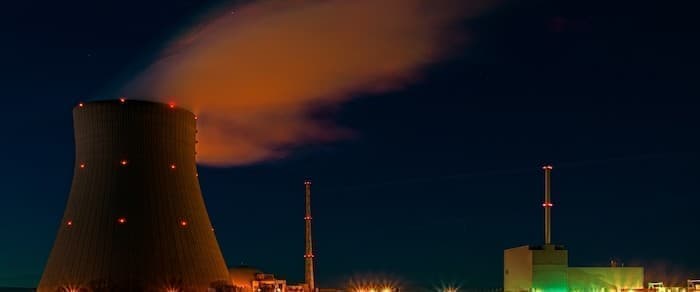
The United States is not only one of the first and foremost nuclear powers of the world, it has also long been the nuclear powerhouse of the planet, being responsible for a whopping two thirds of global nuclear energy production. Domestically, the United States’ nuclear power plants account for approximately 20 percent of the nation’s total electricity and produce over 50 percent of the entire country’s carbon-free energy generation. But these superlatives, both global and domestic, won’t last. As nuclear energy grows around the world, the industry is in deep trouble in the U.S., where the aging nuclear fleet has been battered by a flood of cheap shale oil and natural gas, and is now barely clinging to life thanks to hefty government subsidies and leaving the shockingly high cost of radioactive waste maintenance to the taxpayers.
New Video Shows Largest Hydrogen Bomb Ever Exploded
A Russian nuclear energy agency released formerly classified footage of the Soviet Union’s 1961 Tsar Bomba test.
BY: William J. Broad | nytimes.com
Hydrogen bombs — the world’s deadliest weapons — have no theoretical size limit. The more fuel, the bigger the explosion. When the United States in 1952 detonated the world’s first, its destructive force was 700 times as great as that of the atomic bomb that destroyed Hiroshima.
And in the darkest days of the Cold War, the Soviets and the Americans didn’t only compete to build the most weapons. They each sought at times to build the biggest bomb of all.
Russia Releases “Tsar Bomba” Test Footage Of The Most Powerful Nuclear Bomb Blast Ever
This previously classified film provides a new and fascinating glimpse into the 50-megaton Cold War nuclear test that occurred nearly six decades ago.
Don’t Preach Nuclear Arms to Archbishop
“That $2 trillion nuclear weapons modernization will do nothing to protect us against the global pandemic impacting Americans now. Further, the Sandia and Los Alamos labs may actually degrade national security with planned new nuclear weapons designs that can’t be tested because of the global testing moratorium. Or worse yet, this may prompt the U.S. back into testing, throwing more gas on the fire of the new nuclear arms race.”
BY: JAY COGHLAN / NUCLEAR WATCH NEW MEXICO, SANTA FE
Monday, August 24th, 2020 at 12:02am
 In response to (the Aug. 13) editorial “Archbishop’s nuclear weapons view needs a homily on reality,” I was one of the speakers at the 75th anniversary commemoration of the Hiroshima atomic bombing, organized by Fr. John Dear, at which Santa Fe Archbishop John Wester eloquently spoke. The editorial declared “neither Wester nor Dear appear to accept the premise there is any deterrent benefit to the nuclear arsenal.”
In response to (the Aug. 13) editorial “Archbishop’s nuclear weapons view needs a homily on reality,” I was one of the speakers at the 75th anniversary commemoration of the Hiroshima atomic bombing, organized by Fr. John Dear, at which Santa Fe Archbishop John Wester eloquently spoke. The editorial declared “neither Wester nor Dear appear to accept the premise there is any deterrent benefit to the nuclear arsenal.”
To the contrary, the Journal perpetuates the delusion that the U.S. nuclear arsenal is just for deterrence, a premise fed to American taxpayers since the beginning of the Cold War. Instead, the U.S. arsenal has always been about nuclear warfighting, starting with the simple fact that we were the first to use it. This continues to this day, as the Pentagon made clear in a 2013 nuclear policy declaration: “The new guidance requires the United States to maintain significant counterforce capabilities against potential adversaries. The new guidance does not rely on a ‘counter-value’ or ‘minimum deterrence’ strategy.”
NOTE: This study has notable implications since the New Mexico congressional delegation touts expanded nuclear weapons programs as an economic engine for northern New Mexico.
Study: Neighboring counties lose money due to LANL
BY: KYLE LAND Copyright © 2020 Albuquerque Journal
SANTA FE — A study conducted by University of New Mexico researchers found that Los Alamos National Laboratory has a negative economic impact on nearby communities, despite employing many people in the area.
Of the seven counties included in the study, governments in six of them were found to be losing money due to LANL’s impact, with the exception of Los Alamos. Those counties include Santa Fe, Rio Arriba, Sandoval, San Miguel, Taos and Mora.
The study, conducted by UNM’s Bureau of Business and Economic Research, found Los Alamos County gained $13 million from economic activity created by the lab, while all other counties lost an average of $1.25 million.
Santa Fe and Rio Arriba counties, home to 40% of the Lab’s employees, had the largest losses, at more than $2 million.
In a Friday presentation of the findings to the Regional Coalition of LANL Communities, Bureau Director Jeff Mitchell said his team calculated how much revenue LANL employees produce for an area versus what it costs a local government to provide services for them.
The study, Mitchell said, found that LANL and its employees tend to spend their money in only a few places.
Thirty-eight percent of the Lab’s spending actually goes to Bernalillo County, with another 42% staying within Los Alamos County, according to the study.
Trump Administration Sends Mixed Signals on Nuclear Weapons Budgeting
“A Senate-passed proposal would grant the Nuclear Weapons Council new authority to edit NNSA’s budget request after the Energy Department crafts it and before the request is submitted to the White House budget office.”
BY:Joe Gould & Aaron Mehta
WASHINGTON ― Defense hawks in Congress are pushing a contentious plan to give the Pentagon a stronger hand in crafting nuclear weapons budgets, but the Trump administration has been sending mixed messaging over recent weeks about whether the change is needed.
The Senate-passed version of the annual defense policy bill would give the Pentagon-led Nuclear Weapons Council a say in the budget development of the National Nuclear Security Administration, a semi-autonomous agency within the Department of Energy that’s responsible for the stockpile’s safety, security, and effectiveness.
NOTE: This article is illustrative of the absolutely key role New Mexico plays in the new nuclear arms race, far beyond just the Los Alamos and Sandia Labs. The Air Force Nuclear Weapons Center is on Kirtland Air Force Base which shares runways with the Albuquerque, NM airport. The new nuclear arms race will be increasingly dangerous with likely hypersonic and cyber weapons.
US Air Force May Have Accidentally Revealed Interest in Hypersonic Nuke
BY: Valerie Insinna
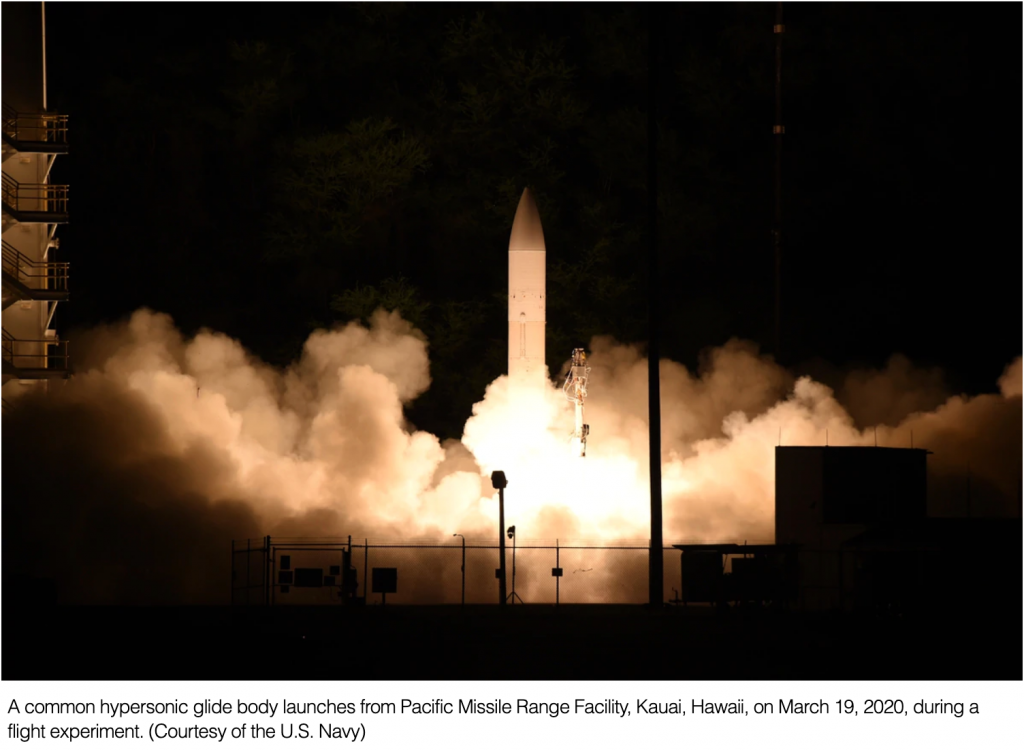
WASHINGTON — The U.S. Air Force has issued, and quietly revoked, a solicitation to industry seeking technologies that would support a hypersonic glide vehicle capable of traversing intercontinental ranges, potentially signaling the military’s interest in a hypersonic nuclear weapon.
According to an Aug. 12 request for information first reported by Aviation Week, the Air Force Nuclear Weapons Center sought ideas for potential upgrades to intercontinental ballistic missiles, including a “thermal protection system that can support [a] hypersonic glide to ICBM ranges.”
USAF Rethinks Relationship Between Conventional, Nuclear Weapons
“What we’re trying to prepare ourselves to do is to respond with whatever force is necessary in a nuclear environment. It’s not so much to fight tactically. Really, the ultimate goal here is to deter. We want to raise that threshold of using nuclear weapons, whether strategic or non-strategic … to the highest level possible.”
To do that, Clark argues the Air Force needs ways to stop others from using nuclear weapons in the first place, and options to retaliate if deterrence fails. Technology, training, and command-and-control requirements all need to be updated to support that approach.
BY: Rachel S. Cohen
The Air Force is crafting new policy that envisions more fluidity between conventional and nuclear weapons, as well as a broader range of options to keep others from using their own nuclear weapons.
The U.S. has long treated conventional and nuclear warfare as separate concepts, but that’s beginning to change, said Lt. Gen. Richard M. Clark, the Air Force’s deputy chief of staff for strategic deterrence and nuclear integration.
DOE Issues Draft RFP for the Oak Ridge Reservation Cleanup Contract
Cincinnati – Today, the U.S. Department of Energy’s Office of Environmental Management (EM) issued a Draft Request for Proposals for the Oak Ridge Reservation Cleanup Contract (ORRCC) procurement at the Oak Ridge Reservation (ORR), in Oak Ridge, Tennessee.
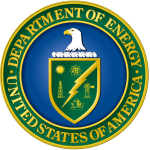 Media Contact:
Media Contact:
Toni Rutherford
(513) 246-1374
Toni.Rutherford@emcbc.doe.gov
The purpose of the Draft RFP is to solicit input from interested parties to assist DOE in developing a Final RFP for this procurement. DOE invites all interested parties to thoroughly examine the Draft RFP and the accompanying procurement website in their entirety and to submit comments to DOE.
DOE anticipates an Indefinite-Delivery/Indefinite-Quantity (IDIQ) contract with a ten-year ordering period from which Firm-Fixed-Price and/or Cost-Reimbursement-type task orders may be issued, with an estimated contract ceiling of approximately $8.3 billion over the ordering period. It is anticipated that task order performance may extend up to five years beyond the end of the ordering period.
None of the Above Podcast
The Atomic Bomb’s First Victims – Beata Tsosie-Pena & Jay Coghlan on Downwinders
"There's this misconception that Hiroshima & Nagasaki were the first victims of the atomic bombing when really it was the people of New Mexico."
Our latest episode commemorates the #75thanniversary of the world's first nuclear attack.
Listen here: https://t.co/3YV9xPl3NV pic.twitter.com/JetubewTNJ
— Eurasia Group Foundation (@EGFound) August 18, 2020
REMEMBERING HIROSHIMA: This Hiroshima survivor returned to the site of the atomic bombing 75 years later.
Hiroshima to a Healthy Tomorrow: Embracing Our Common Humanity in a Virtual Rally
|
|
OREPA challenges NNSA’s “Final Supplement Analysis.”
The Oak Ridge Environmental Peace Alliance, along with Nuclear Watch New Mexico, has challenged the National Nuclear Security Administration’s latest justification for the Uranium Processing Facility bomb plant under construction at the Y-12 National Security Complex in Oak Ridge, Tennessee. In a letter to the Secretary of Energy and the Administrator of the NNSA, OREPA and NWNM pointed out that the Final Supplement Analysis, released in July, falls far short of the “hard look” required by the National Environmental Policy Act.
See OREPA Comments
The Final Supplement Analysis is NNSA’s attempt to comply with the order of the federal court in Knoxville, Tennessee. The court, in September of last year, ruled in favor of OREPA, NWNM, the Natural Resources Defense Council and four individual plaintiffs who argued that NNSA is in violation of NEPA, the law that requires federal agencies to consider the environmental impacts of their actions.
SEE ALSO:
[ILLINOIS] ComEd, Madigan Sued for $450M in Racketeering Suit
Illinois electric customers filed a federal civil racketeering lawsuit against ComEd and state House Speaker Michael Madigan, seeking more than $450 million in damages.
Breaking news update: Today, August 10, a putative class of Commonwealth Edison customers filed a civil racketeering lawsuit against Illinois Speaker of the House Michael Madigan, Commonwealth Edison Company (“ComEd”), ComEd’s parent Exelon Corporation, and several other defendants. Read all the details here.
BY: Michael Yoder | rtoinsider.com
The recent Illinois lobbying corruption scandal involving Exelon Corporation, its subsidiary Commonwealth Edison and Democratic House Speaker, Michael Madigan, demonstrates the extent to which nuclear “power” is about more than electrons.
The FBI arrests of the Ohio House Speaker and five others in a $60 million bribery/corruption scheme; the $10 billion Exelon nuclear bailout in New York; the questionable circumstances surrounding Exelon’s 2016 PepCo merger; and the South Carolina $9 billion SCANA fraud case, suggest that this may be a national pandemic.
DARK CIRCLE: The Sundance Grand Prize-winning classic doc about the dangers of the atomic age – newly restored!
Dark Circle – Official Trailer from First Run Features on Vimeo.
It’s been 75 years this month since the start of the Atomic Age, with the U.S. nuclear bombing of Hiroshima and Nagasaki killing hundreds of thousands of civilians, but its trail of destruction has never ended.
Public Interest Group Requests DOE Prepare “Programmatic Environmental Impact Statement” on Plutonium Disposition, in Support of Recommendation by National Academies of Sciences Pane
Plutonium Disposition via “Dilute & Dispose” to Bring at Least 22.5 Metric Tons More of Plutonium to Savannah River Site, On Top of 11.5 MT of Pu Already at SRS, Must Not be Stranded if Project Changes
Link to SRS Watch’s August 11 Letter to DOE on Plutonium Disposition and Need for PEIS
Savannah River Site Watch
https://srswatch.org/
Columbia, South Carolina
For immediate Release
August 12, 2020
Contact: Tom Clements, Director, SRS Watch, tel. 803-834-3084, cell 803-240-7268
Columbia, SC – The U.S. Department of Energy must prepare an overarching environmental analysis of slow-moving plans to process and dispose of surplus weapons plutonium at Savannah River Site and other DOE sites, according to a request made by Savanna River Site Watch, a public interest group providing oversight of SRS and DOE.
The August 11, 2020 letter to key DOE officials highlights reasons for preparation of a “Programmatic Environmental Impact Statements” (PEIS) on plutonium disposition and affirmed support for a recent recommendation by a panel of the National Academies of Sciences (NAS). A PEIS, prepared under the National Environmental Policy Act, would review the need for the project, assess DOE system-wide plutonium-disposition impacts and would analyze various sites to be utilized, including SRS, Los Alamos National Lab in New Mexico and the Pantex site in Texas (where more than 15,000 plutonium pits removed from weapons are stored).
New Mexico is still waiting for justice 75 years since the Manhattan Project
The state also faces coronavirus on this anniversary.
BY: Bernice Zamora Gutierrez & Paul Lopez Pino | thehill.com
While our nation struggles to survive the COVID-19 pandemic, New Mexicans are already engaged in a deadly health crisis that has cost the lives of thousands of our beloved family and community members for the past 75 years. This crisis is the overexposure to radiation from the world’s first nuclear bomb detonation at Trinity Site in south central New Mexico on July 16, 1945. In the process it made many New Mexicans the first “Downwinder” communities exposed to radiation from nuclear weapons. The Trinity test in New Mexico was followed by the bombing of Hiroshima and Nagasaki three weeks later and we are all memorializing our dead on this 75th anniversary of the nuclear age. And just as the country is waiting for a pandemic recovery plan, New Mexicans are still waiting to be included in the Radiation Exposure Compensation Act (RECA) found in U.S. House Bill 3783.
Obscure agency writing off state politician’s debt
““…Romero and various board members charged taxpayers for lunches in and around Santa Fe. These meals for a select group in no way furthered the public interest. They only benefited coalition insiders.”
BY: Milan Simonich | santafenewmexican.com
You miss a few payments on the $7,800 you owe on your car. A repo agent will take away your ride and your pride while the neighbors watch.
You fail to make payments on a years-old $7,800 credit card bill. The lender will make certain you suffer from the worry of being sued. All the while your debt will balloon with interest charges and late fees.
That’s the real world. Life isn’t as hard in the echelon of state Rep. Andrea Romero and her former employer, the Regional Coalition of LANL Communities.
The coalition’s board claims Romero still owes it $7,800 for impermissible expenses accrued during her tenure as its executive director from March 2016 to February 2018. It asked Romero in May to pay the bill.
Nuclear Power goes South in South Carolina
“It looks like crime might well pay after all.”
That was the weary and only slightly tongue-in-cheek conclusion drawn by longtime anti-nuclear campaigner, Tom Clements recently, after a former South Carolina nuclear utility executive pled guilty to fraud in federal court.
BY: Linda Pentz Gunter | beyondnuclear.org
Clements is the director of Savannah River Site Watch, but his activism has, for decades, extended well beyond the perimeter of that vast nuclear site.
For years, Clements and others have followed — and attempted to stand in the way of — the forced march of South Carolina ratepayers toward nuclear fiasco. When it finally unraveled in late July, there was only cautious cause for celebration.
On July 23, Stephen Byrne, the former COO of SCANA, the South Carolina utility originally in charge of the construction of two new nuclear reactors in the state, pled guilty in a massive nuclear conspiracy that defrauded ratepayers, deceived regulators and misled shareholders.
Hiroshima survivor Dr. Hideko Tamura Snider, August 9, 2020
On August 9, 2020, Dr. Hideko Tamura Snider, author of “One Sunny Day” and “When A Peace Tree Blooms,” joined WILPF US Disarm/End Wars Committee and #HiroshimaNagasaki75 in describing her experiences before, during and after the Hiroshima bomb, and appealing to us all, “I depend on all of your energy, please continue what you are doing to rule out violent means, especially this inhumane, horrible weapon…. We are not barbarians, we are humans, and let us be truly and fully human….”
https://youtu.be/KYzuoGuqg34
75th Anniversary Timeline webinars at the WILPF US Disarm Committee YouTube channel – https://bit.ly/wilpfus-disarmyoutube
Jay Coghlan on The Richard Eeds Show August 3, 2020
The Richard Eeds Show. 8/3 – Jay Coghlan of Nuclear Watch New Mexico on The Event Commemorating the 75th Anniversary of the Bombing of Hiroshima.
Anti-nuclear protests at Kings Bay
“Our mission is to stop the arms race…it’s a security risk and phenomenally expensive. This has become a business model and it’s deadly.” – Glenn Carroll, coordinator of Nuclear Watch South
By: GORDON JACKSON / thebrunswicknews.com
Anti-nuclear protesters hold signs near the entrance to Naval Submarine Base Kings Bay on the 75th anniversary of the first atomic bomb dropped on Hiroshima, Japan. Gordon Jackson/The Brunswick NewsST. MARYS / Organizers of an annual protest against nuclear weapons at Naval Submarine Base Kings Bay expected a large crowd to commemorate the 75th anniversary of the first atomic bomb dropped on Hiroshima, Japan, to help hasten the end of World War II.
Five people ended up standing outside a base gate Thursday holding signs with anti-nuclear weapons messages.
Glenn Carroll, coordinator of Nuclear Watch South, said the ongoing COVID-19 pandemic compelled many who were planning to attend to stay home for health concerns. But Carroll said her trip from Atlanta to join others with concerns about nuclear weapons Thursday was worth the time.
How New Tech Raises the Risk of Nuclear War
75 years after Hiroshima and Nagasaki, some experts believe the risk of the use of a nuclear weapon is as high now as it has been since the Cuban missile crisis.
BY: BRYAN WELSH | axios.com
The big picture: Nuclear war remains the single greatest present threat to humanity — and one that is poised to grow as emerging technologies, like much faster missiles, cyber warfare and artificial intelligence, upset an already precarious nuclear balance.
What’s happening: A mix of shifting geopolitical tensions and technological change is upsetting a decades-long state of strategic stability around nuclear weapons.
- Strategic stability is when no country has an incentive to launch a first nuclear strike, knowing that doing so would inevitably lead to a catastrophic response. It’s the “mutual” in “mutually assured destruction.”
- Arms control deals like the Intermediate-Range Nuclear Forces Treaty are collapsing, while faster hypersonic missiles are shrinking the already brief minutes available to decide how and whether to respond to a potential nuclear attack, meaning “the possibilities of a miscalculation are unfortunately higher than they have been in a long, long time,” says former Energy Secretary Ernest Moniz.
- As concerning as rising tensions are between the U.S. and Russia, or between the U.S. and a more assertive China, experts worry even more about the destabilizing effect of emerging technologies like cyber warfare and AI.
- “The black box of AI in the future of war makes it almost inherently unpredictable,” says P.W. Singer, a strategist at New America and author of “Burn-In” — and unpredictability is anathema to a nuclear balance held in place by predictability.
75 years after Hiroshima, should U.S. president have authority to launch nuclear attack?
On August 6, 1945, the United States dropped the first atomic weapon on Hiroshima, Japan. Seventy-five years later, [PBS] NewsHour revisits how the president became the sole authority on when nuclear weapons are used. Nick Schifrin reports and talks to former Secretary of Defense William Perry, co-author of “The Button: The New Nuclear Arms Race and Presidential Power from Truman to Trump.”
BY: Nick Schifrin | pbs.org
Judy Woodruff:
On August 6, 1945, the United States dropped the first atomic weapon on Hiroshima, Japan. In the coming days, we will examine this 75th anniversary, the bomb’s immediate aftermath and its lasting legacy. Today, Nick Schifrin looks at the president’s sole authority to launch such a weapon and how that authority came to be.
The 75th Anniversary of Hiroshima and Nagasaki: A Renewed Call for Our Day
“A world of peace, free from nuclear weapons, is the aspiration of millions … ” — Pope Francis, Address at Atomic Bomb Hypocenter Park (Nagasaki), November 24, 2019.
PEOPLE OF GOD – Santa Fe Archdiocese, August 2020
PRAY
Pray with your community for the causes of peace and nuclear disarmament to be made a reality.
- Sample bulletin announcements and prayers of the faithful for use on August 2nd and 9th, 2020.
- Share this prayer (en Español) with your networks, or other prayers for peace on August 9th.
LEARN
Learn about what the Church teaches regarding nuclear weapons.
- Nuclear Weapons and Our Catholic Response: A Catholic Study Guide for use with the filmNuclear Tipping Point, revised June 2020.
- Statements of the U.S. bishops on Nuclear Weapons
- Pope Francis on Nuclear Weapons at Atomic Bomb Hypocenter Park (Nagasaki), November 24, 2019.
ACT
Put what your faith into action by raising your voice to support nuclear disarmament.
- Tell Congress to support extension of the New START Treaty and a continued U.S. moratorium on nuclear testing.
- Ask your friends and family to join you in taking action.
On 75th Anniversary of Japan Nuclear Bombings, Sierra Club Continues Calls for Elimination of Nuclear Weapons
Today, the Sierra Club rises with the survivors of the Hiroshima and Nagasaki nuclear bombings in continuing our call for an elimination of all nuclear weapons worldwide. The creation and storage of nuclear weapons is inherently risky, and accidents, testing, and use of nuclear weapons are recklessly and unnecessarily dangerous for communities — particularly low income and communities of color — and our environment.
“The Sierra Club calls on Congress to resist the current renewal of the nuclear arms race and to ban the use of nuclear weapons.”
Thursday, August 6, 2020 – Contact: Cindy Carr, cindy.carr@sierraclub.org
 WASHINGTON, D.C. — To commemorate the 75th anniversary of the WW II nuclear bombings of Hiroshima and Nagasaki, the Sierra Club has joined with the Hibakusha Survivors in calling for the elimination of all nuclear weapons globally. Since 1945, nearly 100,000 nuclear weapons have been manufactured, costing trillions of dollars and destroying communities and the environment through the mining, refining, and weaponizing of uranium.
WASHINGTON, D.C. — To commemorate the 75th anniversary of the WW II nuclear bombings of Hiroshima and Nagasaki, the Sierra Club has joined with the Hibakusha Survivors in calling for the elimination of all nuclear weapons globally. Since 1945, nearly 100,000 nuclear weapons have been manufactured, costing trillions of dollars and destroying communities and the environment through the mining, refining, and weaponizing of uranium.
The Sierra Club opposes the creation and testing of nuclear weapons and supports the Treaty on the Prohibition of Nuclear Weapons (TPNW).
Urgency to bear witness grows for last Hiroshima victims
“We must work harder to get our voices heard, not just mine but those of many other survivors,” Lee [ Jong-keun] said in an interview Tuesday at the Hiroshima Peace Memorial Museum. “A nuclear weapons ban is the starting point for peace.”
Mari Yamaguchi Associated Press | santafenewmexican.com
HIROSHIMA, Japan
For nearly 70 years, until he turned 85, Lee Jong-keun hid his past as an atomic bomb survivor, fearful of the widespread discrimination against blast victims that has long persisted in Japan.
But Lee, 92, is now part of a fast-dwindling group of survivors, known as hibakusha, that feels a growing urgency — desperation even — to tell their stories. These last witnesses to what happened 75 years ago Thursday want to reach a younger generation that they feel is losing sight of the horror.
The knowledge of their dwindling time — the average age of the survivors is more than 83 and many suffer from the long-lasting effects of radiation — is coupled with deep frustration over stalled progress in global efforts to ban nuclear weapons. According to a recent Asahi newspaper survey of 768 survivors, nearly two-thirds said their wish for a nuclear-free world is not widely shared by the rest of humanity, and more than 70 percent called on a reluctant Japanese government to ratify a nuclear weapons ban treaty.
Atomic-bomb survivors seek new ways to keep their memories alive
Around the world, non-proliferation efforts are faltering
For seventeen year-old Takeoka Chisako, August 6th, 1945 was supposed to be a day off. She had planned to meet two girlfriends at 8:15 that morning, at a train station on the west side of Hiroshima. She was running late, and as she stepped outside her house she lifted a pocket mirror to her face. Then she saw a flash and heard a bang. When she regained consciousness she found herself lying in a potato field 30 metres away, a mushroom cloud rising in the sky. People with charred skin dangling from their arms came rushing over a nearby hillside. They cried for help, but were too feeble to speak their names and too weak to drink the water Ms Takeoka brought them. “Then one by one, they died,” says Higashino Mariko, Ms Takeoka’s daughter.
Hiroshima after 75 years: Walking the path of the atomic bomb
74-year-old [Kosei Mito] turns to a page in one of his binders with a large quote Pope John Paul II made during a visit to Hiroshima in 1981, one that’s inscribed on a memorial inside the Hiroshima Peace Museum.
“To remember the past is to commit oneself to the future.”
“You’re walking the path of the atomic bomb.”
Unlike the pandemic, nuclear war can be stopped before it begins
Seventy-five years after Hiroshima and Nagasaki, the anti-nuclear movement is taking big steps toward abolition.
BY: MARINA MARTINEZ | wagingnonviolence.org
Nuclear weapons have been posing a threat to humanity for 75 years — ever since the U.S. bombings of Hiroshima and Nagasaki in August 1945.
These days, our focus is understandably on the COVID-19 virus and the threat it poses to human life. But as we commemorate the anniversary of these bombings, it is important to acknowledge that unlike the coronavirus, nuclear weapons can only be remediated with prevention. Millions of people could be killed if a single nuclear bomb were detonated over a large city, and the added threats of radiation and retaliation could endanger all life on Earth.
U.S. LAUNCHES MINUTEMAN III MISSILE TEST LESS THAN 48 HOURS BEFORE 75TH ANNIVERSARY OF HIROSHIMA ATOMIC BOMBING
“The unnecessarily provocative test by the U.S. today is an important reminder that the nuclear threat remains very real, and that there are people in this country – along with a few other countries – who are willing to sacrifice us all in a battle that can never be won and must never be fought.”
 For Immediate Release Contact: Sandy Jones (805) 965-3443; sjones@napf.org
For Immediate Release Contact: Sandy Jones (805) 965-3443; sjones@napf.org
Rick Wayman (805) 696-5159; rwayman@napf.org ragingpeace.org
Santa Barbara, CA – The U.S. Air Force launched an unarmed Minuteman III intercontinental ballistic missile Tuesday morning, August 4, at 12:21 a.m. PDT from Vandenberg Air Force Base. The missile traveled over 4,200 miles to the Kwajalein Atoll in the Marshall Islands.
While Air Force Global Strike Command asserts that missile tests are scheduled years in advance, it is difficult to ignore the timing of this test – less than 48 hours before the 75th anniversary of the U.S. atomic bombing of Hiroshima.
Rick Wayman, CEO of the Nuclear Age Peace Foundation, a non-profit based in Santa Barbara committed to solving the most dangerous technological, social, and psychological issues of our time, including the abolition of nuclear weapons, commented on the missile test. He said, “This week, the majority of the world is solemnly remembering the 75th anniversaries of the U.S. atomic bombings of Hiroshima and Nagasaki, and vowing that such a thing will never happen again. Hundreds of thousands of our fellow human beings were indiscriminately slaughtered by two primitive U.S. atomic bombs in August 1945. The weapon that was tested this morning is designed for far greater damage.”
Nuclear News Archives – 2021
Nothing Found
It seems we can’t find what you’re looking for. Perhaps searching can help.



